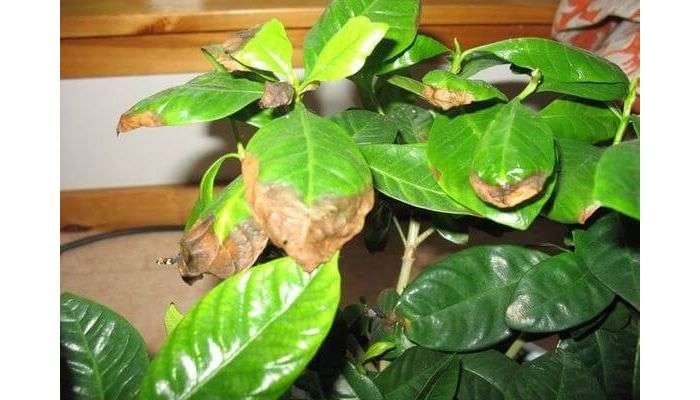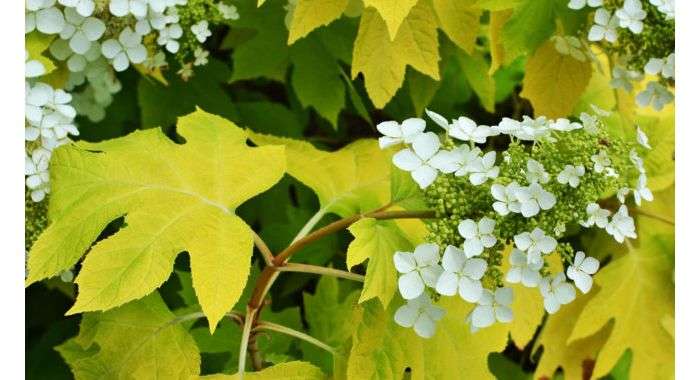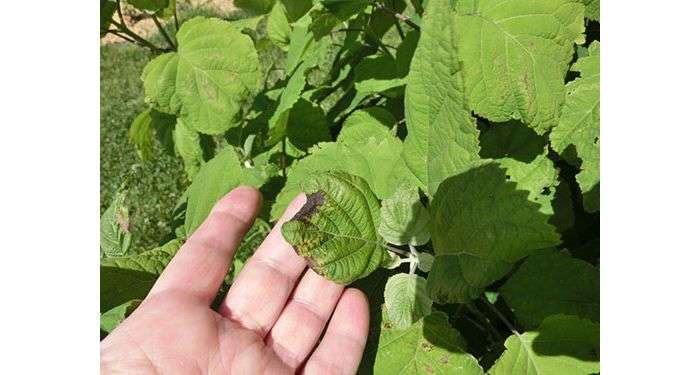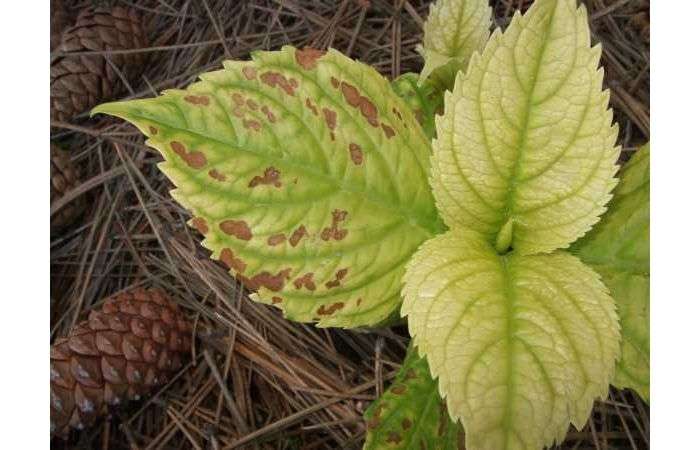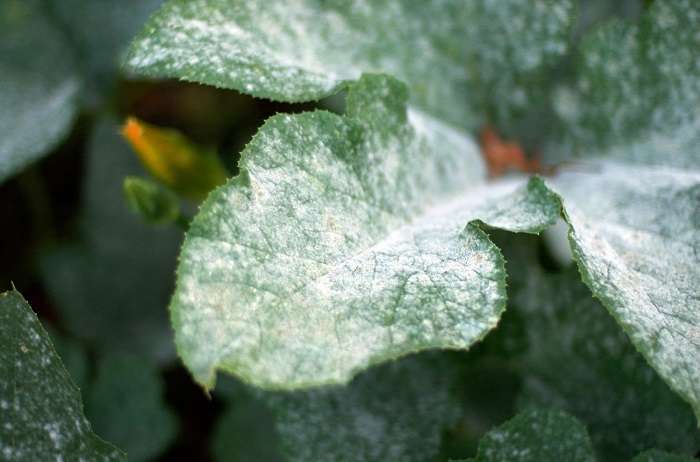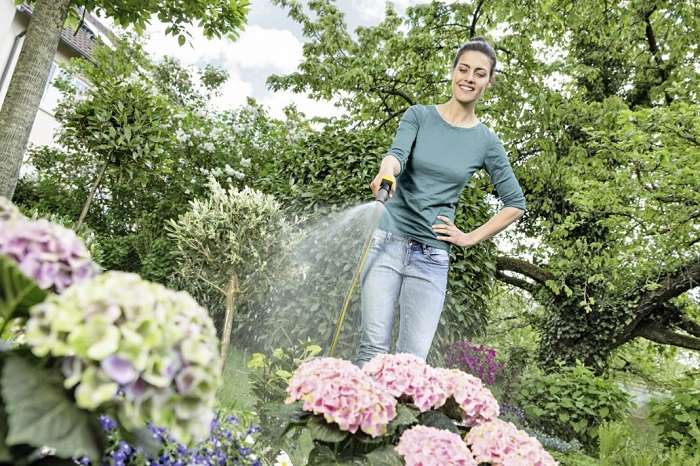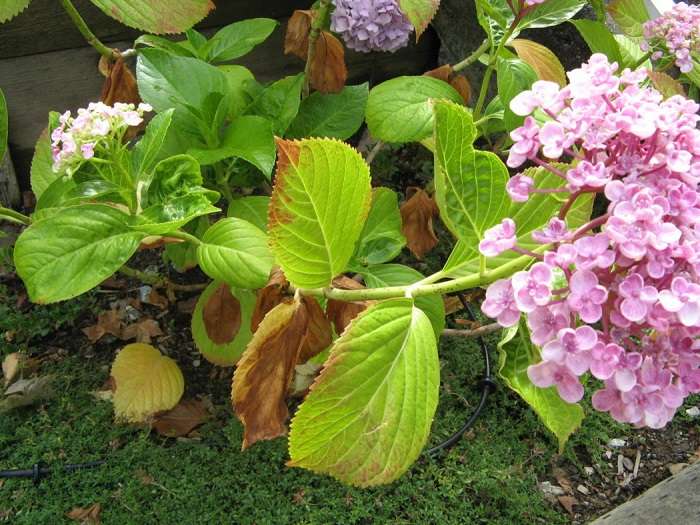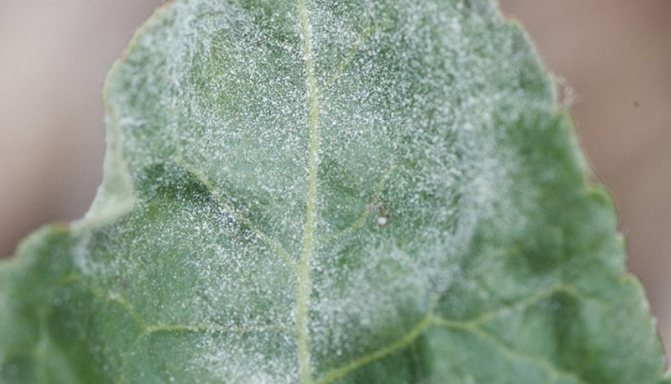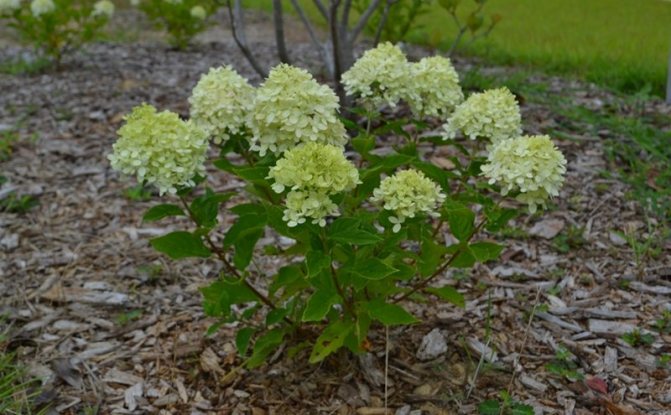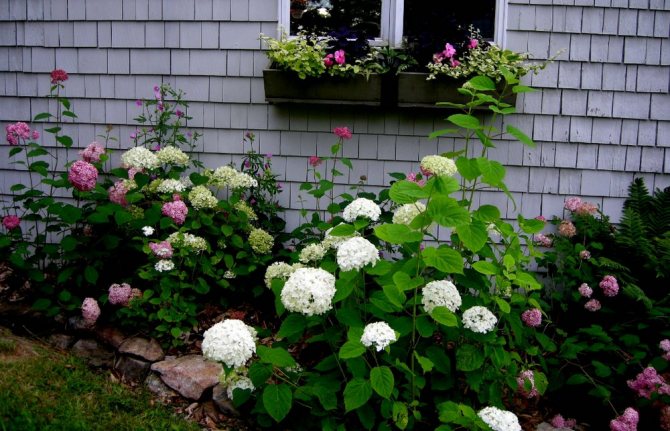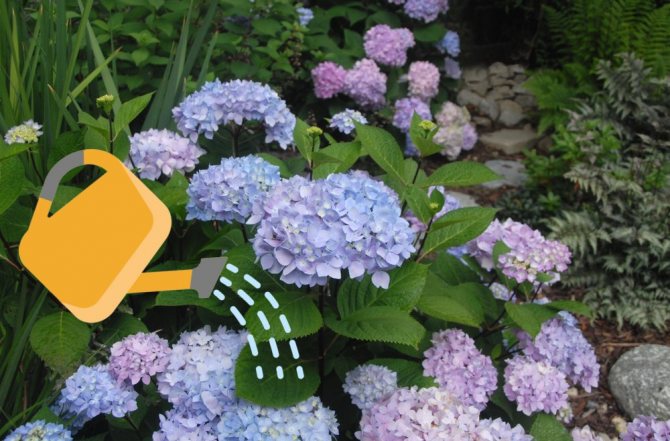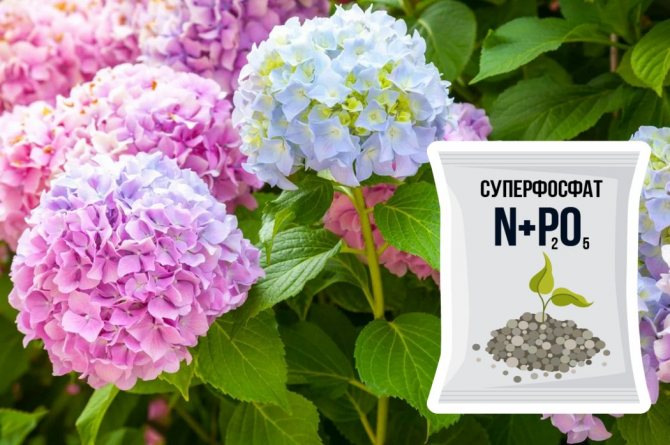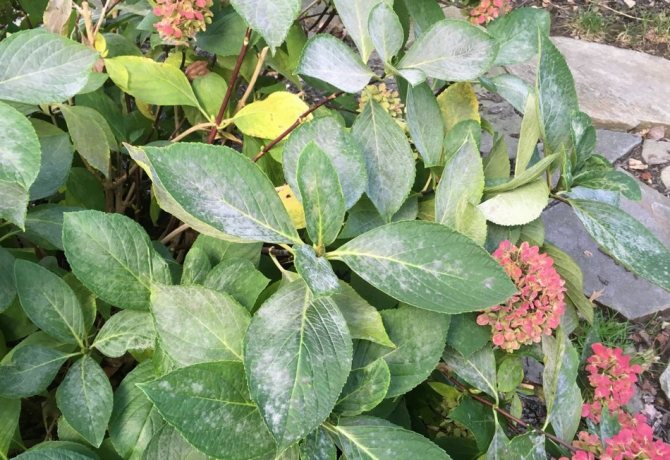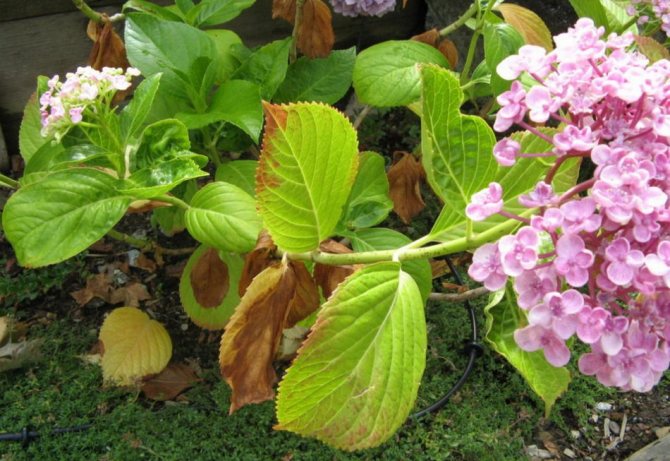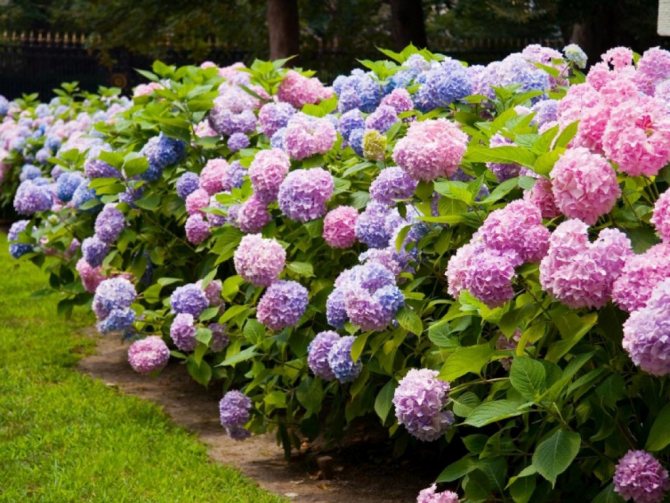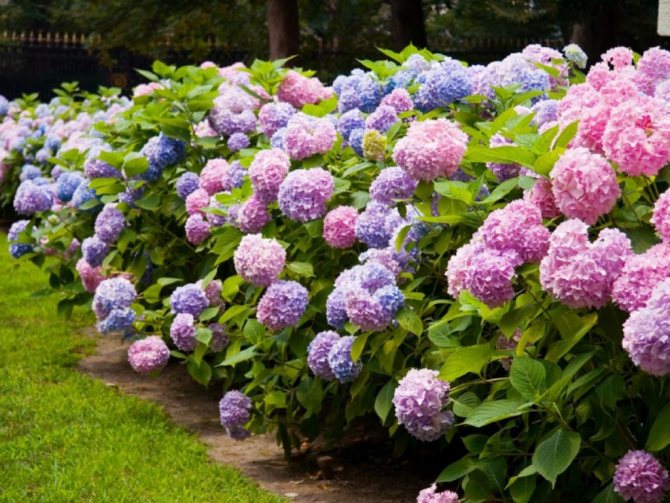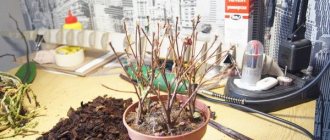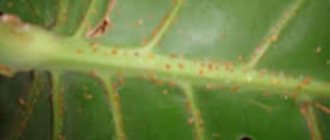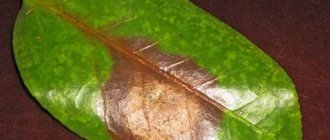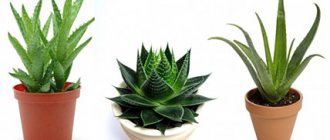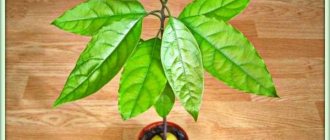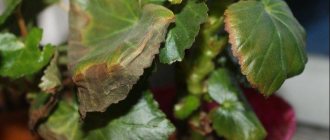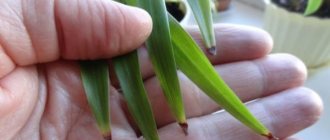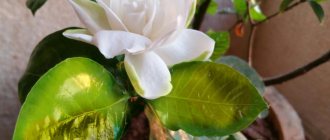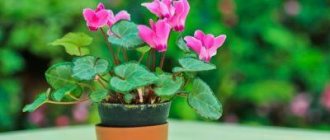How to quickly save a hydrangea? Hydrangea care errors in the garden - why is it dying? Read the article on how to properly care for a garden hydrangea so that it does not wither.
Both amateurs and professionals sometimes make mistakes. Despite the fact that the shrub began to fade, having identified the reasons for the changes and choosing a treatment, it is possible to bring the hydrangea back to life in most cases.
Why does the garden hydrangea wither:
- We haven't watered for a long time.
- Little light.
- Lack of fertilizers in the soil.
- Frozen in winter.
- There was a transplant - the roots were damaged.
- Poured or directed water to the leaves.
- Chlorosis of leaves - minerals washed out.
One of the care segments was disrupted due to which the hydrangea reacted with wilting, yellowing or shedding of leaves.
Watering hydrangeas - where do the problems lie?
Hydrangea is called hygrophilous plant
, so they try to water regularly. If there has been no moisture for a long time, or the soil mixture is irregularly dried, changes in the state of the shrub can be observed. The garden hydrangea also withers during the transitional periods - spring and autumn - when several changes occur: temperature indicators, air humidity, lighting. In the summer, hydrangea
suffers under aggressive rays
- the earth dries up quickly.
It is also possible to fill in the hydrangea. Constant, abundant watering without drying out the soil is the worst maintenance tactic. In this case, they also try to regulate the intensity of the procedures, observing the frequency of moisturizing.
Garden hydrangea lighting
As noted above, under direct rays in the summer, hydrangea gets sick. The leaves are burned out shoots are depleted
... You can try a shading option - cover the hydrangea or diffuse aggressive rays. If you are planning a transplant, choose the southeastern section. We do not recommend a completely shaded place.
- hydrangea does not tolerate darkness
.
Winter period and transfer
If the hydrangea is poorly insulated for the winter, the bushes will freeze over.
Separately, both the root and aboveground systems can be affected. There is also a delayed response to stress - the hydrangea was
weakened by temperature changes
... Another unfavorable factor was added and the shrub withers.
Likewise with a hydrangea transplant after winter - weakened root system
, violation of the technique of planting or care affects the condition of the hydrangea. It is necessary to carefully prepare the soil and apply anti-stress drugs after moving.
Nutritious potting soil
Both after transplanting and at the beginning of the growing season, the hydrangea is in urgent need of fertilizers, since with each new season the roots are depleted.
By the way, chlorosis on leaves
hydrangea appears if trace elements are washed out of the ground, namely iron.
How to process a garden hydrangea so that it does not wither:
- "Zircon";
- Epin;
- Kornevin;
- A mixture of trace elements;
- "Nitrofoska" - a complex of minerals;
Resume leaving in parallel
- soil and air moisture, sun exposure and, if possible, adjustments to temperature readings.The impact of the latter can be enhanced or reduced through related procedures: spraying, watering, neutralizing the negative impact on feeding and adding anti-stress complexes.
↓ Share your observations, why does the garden hydrangea wither?
(There are no ratings yet, be the first)
Why indoor hydrangea dries
Large-leaved hydrangea due to its active development and garden origin after flowering is recommended to be transplanted annually into new soil, with the obligatory loosening of the root ball. Very often, as a result of transplantation, the tips of the leaves begin to dry in a perennial. There can be many reasons for this phenomenon, but in most cases these are:
1. Injury to root hairs during transplantation, which is why the bush is simply "overbalanced".
2. Wrong choice of potting mix.
3. Unsuitable pot.
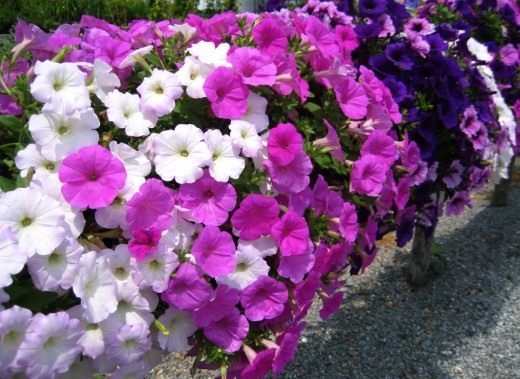
You may be interested in an article on how and with what to highlight petunia seedlings.
You can read an interesting article with tips for growing Gioconda cascading petunia here.
We suggest reading an article describing the petunia Ramblin.
In addition, there are several more reasons not related to plant transplantation, due to which the leaves begin to dry out. These include:
1. Insufficient watering and spraying.
2. Dry indoor air.
3. Lack of trace elements in the soil.
4. Improper lighting.
It is worth considering each of the reasons separately to find out why the leaves of the room hydrangea dry out.
Photo
Next, you can see the photo of the indoor hydrangea plant:
Transplant is a serious matter
If the dryness of the leaves was the result of a careless flower transplant (unfortunately, no one is immune from this), then it is worth considering that this condition can last one or even two months until the bush fully regains strength and health.
Even in the process of transshipment of an earthen coma, it is impossible to avoid disruption of the formed root system. Meanwhile, small roots and hairs, entangling the soil in a dense network, play an important role in moisture absorption. Their damage leads to a temporary disruption of plant nutrition. It can be revived by effective and efficient watering with the addition of Zircon once a week.
Improperly selected soil can also cause this phenomenon. As you know, this crop requires acidic soil. Therefore, it is impossible to plant hydrangea in humus. In its pure form, it does not give the soil acidity necessary for this plant. When planted in neutral or alkaline soil, flower development slows down.
The choice of a new pot is no less important when transplanting. It should be wide, but shallow, since the root system does not grow deeper, but grows mainly in width. The new pot should have a diameter of 1.5 times the old container. But when planting a bush in light soil, you do not need to get involved in increasing the volume of the pot, otherwise in the summer the plant will need more frequent watering.
Fungal diseases
Caused by small pathogenic fungi. These are dangerous diseases of hydrangea, their treatment can be difficult. This is usually associated with high humidity, soil and plant contamination.
Fact! The petiolate hydrangea is more resistant to disease.
White rot
The fungus attacks the roots and absorbs nutrients for the shoots. Infection occurs through various plant debris, from neighboring plants. It develops especially rapidly in closed greenhouses, hotbeds, open ground is not so dangerous. If you do not fight the fungus, the plant will die and infect the nearest "neighbors".
- Darkened shoots.
- Rotting stems near the ground.
- White, cotton-like bloom on the leaves.
Later, dark spots and blotches appear on the plaque. If the infection has reached the stage of white bloom, it is better to remove the plant, otherwise it will infect the entire flower garden.
Comprehensive treatment is necessary, otherwise the fungus will begin to spread.
- Cut out infected areas and process the sections with a strong solution of potassium permanganate.
- Spray the plants with products containing copper (Bordeaux mixture, copper sulfate solution and special preparations for white rot are suitable).
Folk remedy for white rot: a teaspoon of vitriol and 3 liters of whey per 6 liters of water. A sprayer is used for processing.
White rot can infect almost all plants in the garden. If the affected area on the plant is too large, it is better to remove it and burn it so as not to jeopardize nearby plants.
Gray rot
Leaves and young soft tissues are affected. Usually appears from waterlogging - excessive watering or too thick foliage, overcrowding of plants. The fungus spreads rapidly in a humid environment.
Symptoms: Soft gray bloom on the leaves. It can dry out and crumble into dust, uneven holes remain in the tissues of the plant.
Treatment: the main thing is to remove dead areas in time and burn them.
- Treat the plant after removing the dead tissue with potassium permanganate, as is the case with white rot. If the disease has gone too far, it is better to destroy the flower so as not to infect others.
- Sick bushes need to be sprayed with a solution of Bordeaux mixture (1% solution) or Fundazol.
Gray rot is no less infectious than white rot, affecting vegetables, fruit trees, flowers, legumes.
Peronosporosis (downy mildew)
It occurs at high humidity levels and high (over 20 ° C) temperatures.
Symptoms: oily, dark spots on the leaves over time. If the treatment is not carried out in time, the spots spread to the stems.
Important! With the treatment of peronosporosis, it is impossible to delay, the fungus is easily treated only at the initial stage of the lesion.
- Remove affected areas. Process the slices with potassium permanganate.
- Spray the plants with 1% Bordeaux mixture solution, Optimo, Cuproxat.
Peronosporosis affects other flowers: sweet peas, marigolds, primrose, chrysanthemum. May also be harmful to vegetable crops.
Powdery mildew is real
Usually affects young, weakened plants. Often associated with excess nitrogenous fertilizers and insufficient watering.
Symptoms: faint yellow-green specks on the leaves, gray, sometimes purple bloom appears on the back of the leaves.
Powdery mildew leads to leaf fall and plant death.
- Remove and burn affected areas.
- Against powdery mildew, only fungicides give a good effect - Fitosporin B, Topaz.
It must be remembered that when using preparations of the fungicidal group, you need to take breaks of 1 year. Otherwise, the fungus can get used to it and develop immunity.
Powdery mildew in different crops has its own pathogens, the hydrangea fungus is not dangerous for other crops on the site.
Septoria
Damp cold summer disease. Leaves are affected, usually the fungus spreads from the lower shoots to the upper ones.
Symptoms: specks up to 5 mm in diameter. Light in the center and dark brown at the edges. With severe damage, spots may appear on the stems.
The affected plant soon begins to dry out, shedding leaves, and may die.
- Removal of affected areas, processing of sections with potassium permanganate, garden pitch.
- Spraying plants with a solution of Bordeaux mixture, garden preparations Rodomit Gold, Profit.
Providing watering and air humidity
Dry leaf tips can be a reaction to insufficient soil moisture. Hydrangea loves moisture, and therefore timely watering is very important for it. Even a short-term lack of moisture can lead to the fact that its leaves begin to dry out.
The situation will be even more aggravated if the flowerpot is on the windowsill under the scorching sun. You can reanimate the plant by placing it in a shaded place, without depriving it of sunlight, and providing abundant watering and additional spraying.
This beautiful moisture-loving flower reacts in the same way to too dry air in the room where it is located. It is worth measuring the level of humidity in the air in the room.
To prevent this problem, you will need to carry out constant spraying or install a simple humidifier in the form of a tray or saucer with wet stones and moss.
Introduction
Gardeners in general can pay sufficient attention to hydrangeas, although this plant is considered one of the most unpretentious. In general, it is not difficult to take care of the plant, but one way or another sometimes gardeners may encounter some problems, due to which the appearance of the plant and its general condition can deteriorate to a noticeable extent. Such problems include the following circumstances:
- diseases of the leafy part of hydrangea
- control of pests and insects that can damage hydrangeas at any stage of its development and growth. Of course, all this requires that the gardener select full-fledged measures to combat these negative manifestations. Despite the fact that hydrangea has a very high immunity and resistance to stress, some natural, climatic and external circumstances can provoke a number of diseases and infections that manifest themselves precisely in the external characteristics of the plant itself. It depends on the gardener how quickly the problem will be detected, and all the necessary measures will be taken to get rid of it. In a neglected state, diseases can harm not only the upper, green part of the plant, but also move to the root system, due to which, over time, the hydrangea weakens and then dies altogether. So you should be very careful about any external negative manifestations, otherwise it will then be impossible to save the hydrangea. In this article, we will talk about the most common diseases of hydrangea, as well as talk about the causes and how you can competently and effectively deal with them so that in the future the disease does not lead to the final death of this amazing ornamental plant.
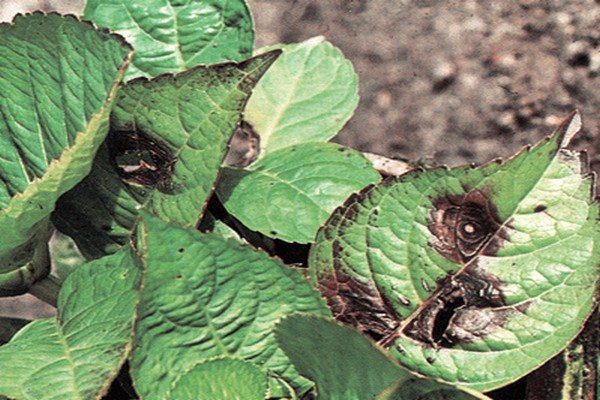

How important is it to feed and choose the right place
Another reason for drying leaves is a lack of nutrients in the soil. The fact is that during the flowering period the plant needs feeding, which should be carried out weekly with any complex fertilizer intended for flower crops. But it is worth considering that hydrangea reacts negatively to high doses of mineral fertilizers, from which its leaves turn yellow. At the end of flowering, fertilizing is gradually reduced.
Indoor hydrangea must be placed correctly in the room. Despite the fact that it is a light-loving flower, its dark green foliage is usually covered with light spots from an excess of sunlight. The best option for the location of the flower pot is the window sills of the east and west windows. In addition, care should be taken to ensure that the foliage does not touch the window glass, otherwise the tips of the leaves will dry out due to burns.
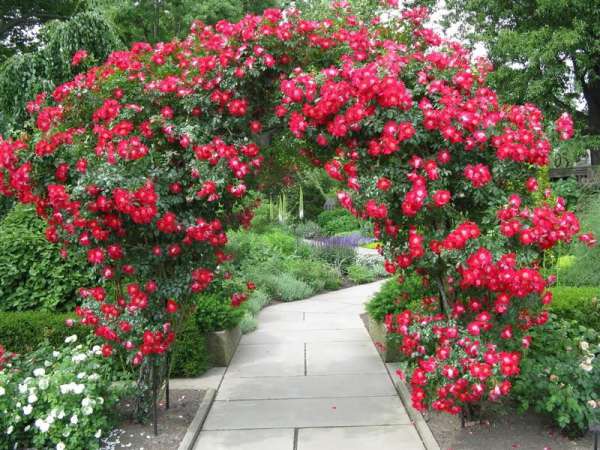

There is an interesting article on how to grow petunia seedlings in peat tablets.
Perhaps you will find an interesting article describing the best varieties of red climbing roses.
It is very important to recognize the problem that has arisen in time so that the assistance provided is timely and correct. Only in this case it will be possible to save the indoor hydrangea and admire its luxurious flowering for a long time.
We suggest you watch a video about what diseases are and why the leaves of hydrangeas dry:
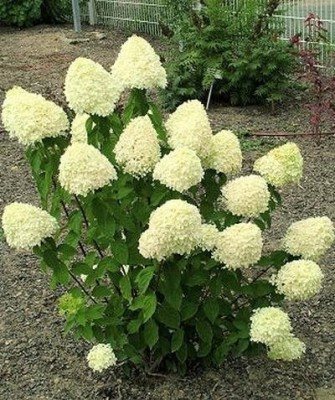

For many years, hydrangea has been considered one of the most delightful decorations in a country garden. It looks very harmonious.Tall bushes with carved leaves, large caps of flowers of various delicate colors will not leave anyone indifferent.
Many gardeners will agree that hydrangea loves constant attention and care. It is not difficult to care for her, but during the cultivation process you may encounter with a number of problems.
The flower is endowed with good immunity, but improper care and the vagaries of nature can provoke the occurrence diseases... It is very important to recognize the problem in time in order to provide timely assistance.
What causes room hydrangea leaves to dry out?
Most often, flower growers ask the same question: why do the leaves of the room hydrangea dry? There may be several reasons for this phenomenon. First of all, these are:
- root trauma during plant transplantation or transshipment;
- watering problems;
- lack of nutrients;
- unsuitable air humidity.
Let's look at each moment separately to identify the reasons why the leaves of the room hydrangea dry out.
One of the most common reasons why indoor hydrangea leaves dry out is to transplant or transship a plant. In this case, root injury occurs, and the plant is simply "sick". This condition can last up to 2 months, at which time it is advisable to water the hydrangea once every 10 days with a solution of the drug "Zircon".
The problem with insufficient or, conversely, excessive watering, as well as low air humidity, can also lead to the fact that the leaves begin to dry out or fall off. Optimal - when the clod of earth does not dry out. In addition, spraying is necessary in the summer.
Another reason that indoor hydrangea leaves dry out is a lack of nutrients. Fertilizing should be done weekly during the entire flowering period.
Many flower growers love hydrangea and it is not surprising, because the large caps of its inflorescences, flaunting with rare pastel shades, look very impressive during flowering, which lasts quite a long time. This houseplant is relatively resistant to diseases and pests.
Nevertheless, flower growers have problems with it, associated with violation of growing conditions, nevertheless arise. For example, it happens that the tips of the leaves of the hydrangea begin to dry out.
And more and more. But the leaves are an important organ of the plant, without them it dies.
Leaf diseases
They occupy a leading number among all diseases.
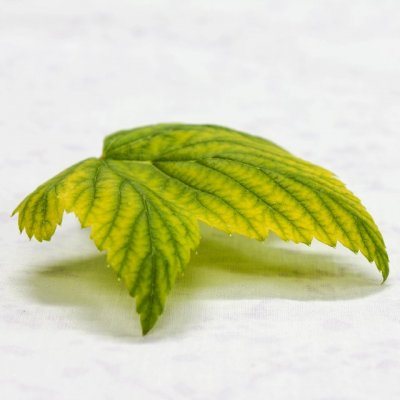

Why do hydrangea leaves turn yellow?
- Yellow foliage may indicate excess moisture. Although hydrangea loves frequent and abundant watering, with excessive accumulation of water, it loses its attractiveness.
- Pay attention to the acidity of the soil. If it is lowered, you can add a few drops of lemon juice per liter of water while watering. Repeat the procedure several times.
- Protect the bush from drafts, hypothermia, sudden changes in temperature.
- Do not plant the flower in open, sunny areas. He will be comfortable in the partial shade of large fruit trees or next to spreading bushes. If it is on the sunny side, try to create diffused lighting conditions.
- Yellow foliage can be due to a lack of nutrients. Feed regularly.
- Waspslook at the leaves. If a grayish bloom appears on them in the form of spots, infection with powdery mildew is possible. Insecticide treatment will be required.
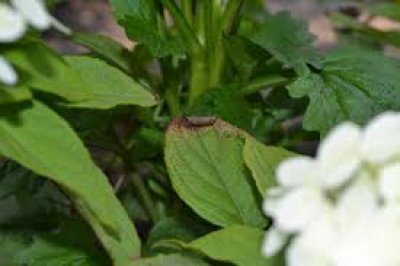

Hydrangea leaves dry, what should I do?
- Lack of moisture, especially in dry summers.
- Dry air. This is often encountered when grown in closed or semi-open greenhouses. It is recommended to ventilate the greenhouse if possible, install a humidifier, and spray the air.
- Sometimes the tips of the leaves begin to dry after improper transplanting, during which the roots were damaged. Even if you stick to the rules, no one is safe from accidental mistakes. We'll have to be patient and get to work. Zircon treatment will be required every 10 days. It may take up to 2 months to restore health and strength.
- Lack of nutrients also affects health, especially during the period of inflorescence and flowering. Fertilizers should be applied at least once every 7-9 days.


Why do hydrangea leaves turn black?
To begin with, the gardener needs to understand whether he is dealing with a sluggish or dry blackening. In each case, there are reasons and ways of plant healing.
How to deal with dry blackening?
In the case of dry blackening, large brownish spots form at the edges of the leaves, they become dry and wither. The reasons:
- Sunburn. Protect bushes from direct sunlight. This applies both when grown in a greenhouse and in an open area.
- Excessively hard water for irrigation. Gardeners often take cold water from a column. But in many areas it contains lime and other impurities. Be sure to defend it before watering. Place large tubs on site and fill them in the morning or evening. It is betterplace in a sunny area so that the water has time to warm up in a day.
How to deal with sluggish (wet) blackening?
It is not difficult to distinguish it by its dark and limp leaves. The reasons:
- Excessive and abundant hydration.
- Drafts, sudden temperature changes, too cold summer. In the latter case, you can protect the root system with a layer of mulch.
- Pay attention to the composition of the earth. Plant the flower in loose, light, nutritious soil. Heavy soil retains moisture, impedes breathing and nutrition.
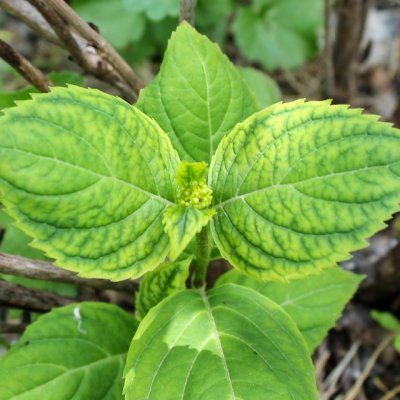

Occurs with iron deficiency. It is characterized by a violation of the formation of chlorophyll. The plates turn yellow, but the veins remain green. Iron may not be enough in the soil or the flower itself, for physiological reasons, has lost its ability to absorb the mineral.
Signs of chlorosis can be different: reduction in the size of leaves and their color, twisting of the plate, deformation of the buds, drying of the shoots.
Control and prevention measures:
- Pay attention to the characteristics of the soil. It should be nutritious, good oxygen to the roots. Water regularly with acidified water to maintain the correct soil balance.
- If the disease has begun to develop, feed the bushes with iron preparations (in chelated form): Ferovit, Antichlorosis and others. You can also prepare iron chelate at home. To do this, you need to dilute 4 grams of citric acid in one liter of water and add 2 grams of ferrous sulfate. The solution can be used for watering and spraying. By the way, iron chelate will act faster if you apply it on the sheet!
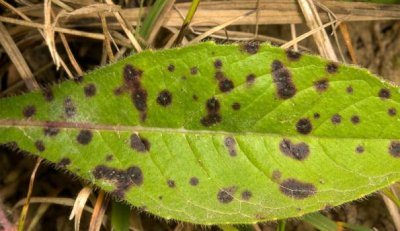

A disease in which dark brown spots 2-6 mm in diameter appear on the leaves (septoria spot). The causative agent is Septoria. Affected leaves gradually turn yellow, die off and fall off. As a result, the plant can completely lose its leaves. When the disease spreads, spots also appear on the petioles and young shoots.
How to deal with septoria disease?
- Fallen leaves need to be collected and destroyed in time in order to prevent the spread of the disease on the site.
- Cut off the affected shoots with the capture of the healthy part. Treat the cuts with a garden broth.
- In the spring, treatment with a solution of Bordeaux liquid is required, as well as chemicals - Ridomit Gold, Profit.
- If the azalea is grown in a greenhouse, keep an eye on the humidity.
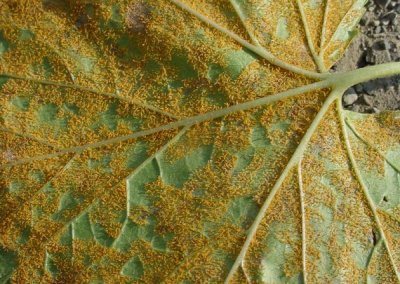

Rust on flowers
This is a fungal disease, during which a rusty tint forms on flowers, leaves and shoots. May be due to excessive planting density, an overabundance of nitrogen in the ground.
Fighting garden hydrangea rust
Treatment with copper chloride is required (40 grams of the drug is diluted in 10 liters of water). Some growers use Bordeaux liquid, but it can leave marks. You can buy drugs: Ordan, Topaz or Falcon.
Cut flower care tips
In order for a hydrangea to stand for a long time, it must be looked after more carefully than others. The standard home care rules apply to it.
- To prolong the life of a flower, it is necessary to prune the stem of the plant. This is done at an acute angle so that the absorbent surface of the stem is slightly larger. This will help the flower to absorb liquid over its entire surface and maintain its beautiful appearance for a longer time.
- The water in the flower vase needs to be changed daily. It is recommended to completely renew the fluid, and not add it. This can upset the acid-base balance and the flowers in the bouquet will die.
- The leaves at the bottom need to be removed - the water should not touch them.
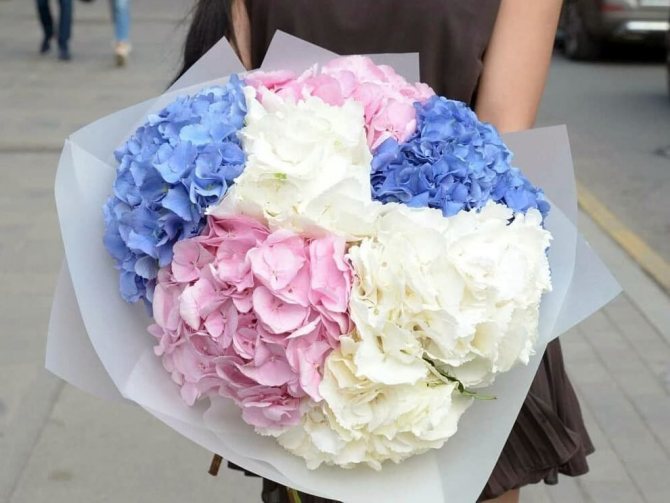

There are special rules that only apply to caring for cut hydrangeas. In addition to shortening the stem from below, several cuts can be made. They need to be placed longitudinally. The length should be approximately 2 cm. This manipulation will increase the flower's water intake. A feature of hydrangea care is the moxibustion of the cut. This is necessary to remove the mucus secreted by the flower. It can clog the vessels through which water is passed - this shortens the life of the hydrangea, and it withers faster.
Avoid placing cut hydrangeas in vinegar or other chemicals. Not only will this not prolong the life of the flower in the bouquet, but it can also be dangerous for the respiratory tract.
To keep the hydrangea in the vase for a long time, you can use special universal means. The main solution used in floristry is Chrysal. Its composition allows you to keep the flowers in the bouquet fresh and beautiful for a long time.
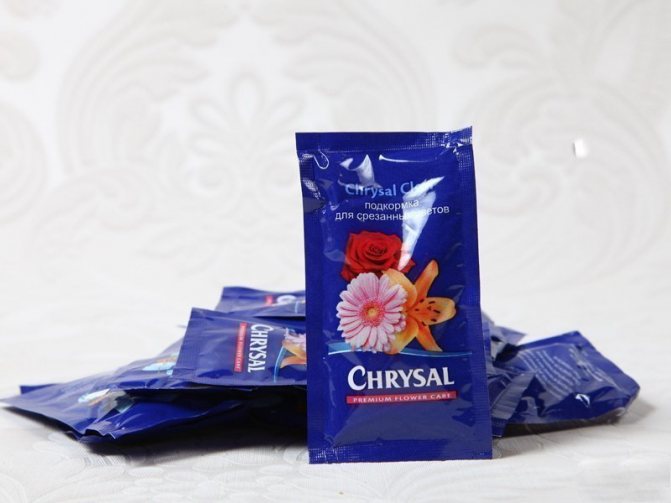

Chrysalis for hydrangeas prolongs life when cut
It is not very difficult to care for a cut hydrangea, but it can make the plant more resilient. With the correct implementation of all the instructions, hydrangea can stand even more than 4 weeks. The exact time depends on the variety. Breeders have bred species specifically for cutting, which for a long time retain an eye-pleasing appearance in a vase of water or as a dried flower.
Pest control
Garden hydrangea often becomes a "target" of various pests. It is important to recognize the onset of the lesion in time and take measures to improve it, otherwise the flower will begin to fade.
Common pests
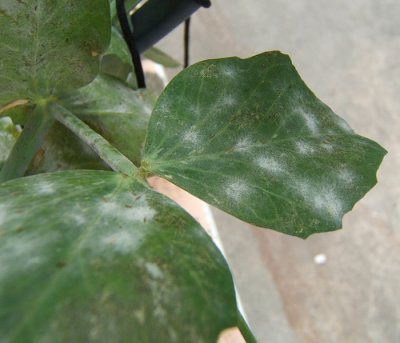

- Downy mildew.
It can be recognized by oily spots on the surface of the leaves. Over time, they spread, turn yellow, acquire a dark shade. A yellowish bloom forms on the underside of leaves and young shoots. Powdery mildew is often found when grown in greenhouse conditions, with high humidity and an air temperature of 17-20 degrees.
To get rid of the pest, you need to carry out the treatment with a soap-copper mixture prepared from 150 grams of green soap, 15 grams of copper sulfate and 10 liters of water.
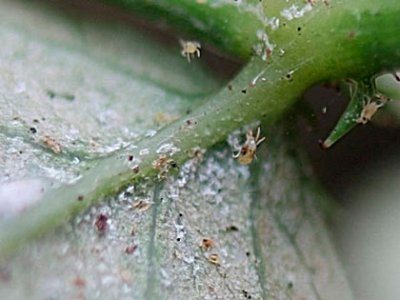

- Spider mite -
settles on the undersides of the leaves, covering them with a brown cobweb. Then they become marbled in color, dry up and fall off. The spider mite is an insidious enemy. At high temperatures (27-30 degrees) and low humidity, it spreads in just 5-7 days.
You can fight the tick with thiophos.
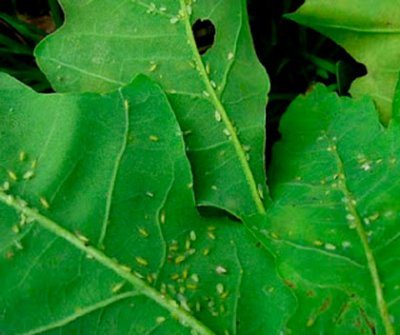

- Green leaf aphid -
no less dangerous pest. It sucks out the juice, leaves a sugary unpleasant discharge in which fungi form. Aphids quickly spread, the leaves turn yellow and crumble. It settles on the lower part of the leaf.
You can fight aphids with insecticidal agents.
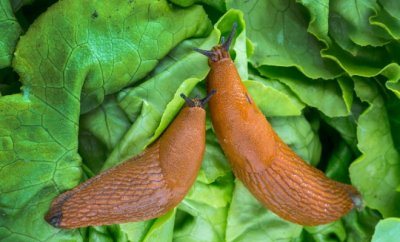

- Slugs -
attack in conditions of too dense and frequent planting. They are harmful by eating foliage and can be controlled with molluscicide (granular formulation). It is scattered near the bushes to the surface of the earth.
How to reanimate hydrangea after winter?
If the flowers were properly prepared before the onset of cold weather (hidden under cover), there will be no problems. With the onset of spring, the flowers will come to life and will delight in the summer with new flowering.But what if the flower was left without shelter in winter? It will be difficult to return the previous look. But, this task is quite feasible.
- Treatment will be required to protect against fungal diseases Bordeaux liquid or copper solution.
- The affected foliage and twigs are removed and the treatment is repeated two weeks later.
- Pay attention to the ground. Acidify it weak lemon solution.
- Be sure to tidy up the appearance of the plant, remove frozen, dry twigs, feed. It will not bloom this year, but if you take all the necessary measures and properly prepare for the next winter, it will gain strength and bloom again in a year.
Hydrangea is a charming flower that loves constant attention and care. Take care of it properly and it will become the main decoration of your summer country garden.
For more photos on the topic of diseases of the garden hydrangea, see below:
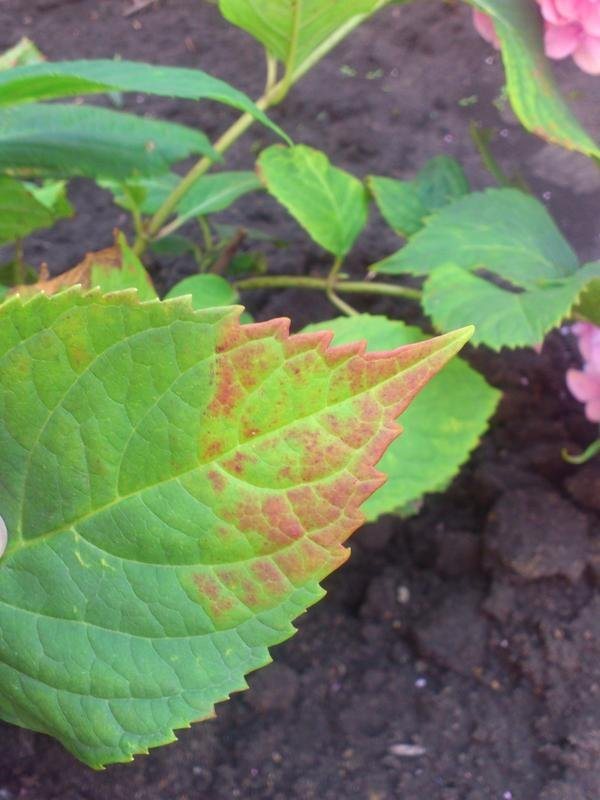

A little about the reasons
Basically, the reasons why hydrangea leaves turn yellow are due to mistakes in care or changes in the environment. But sometimes the plant is damaged by pests. Consider the possible reasons in more detail.
If the bush grows in the shade or in an open, sunny area, its leaves may begin to turn yellow, brown and dry out. The light regime is very important for the plant - it prefers bright, but diffused lighting.
He will also be comfortable in partial shade from trees or near bushes. The scorching sun burns the leaves, and the lack of light affects both foliage and flowering.
If the yellowing is due to improper lighting, the hydrangea should either create suitable conditions or transplant it to another place.
Although hydrangea is a moisture-loving plant, strong waterlogging primarily affects the leaves. They start to turn yellow and then fall off. If this happens, it is important to reduce the frequency and volume of watering and not flood the plant in the future.
Drafts
Hydrangea is a thermophilic flower, therefore, sudden changes in temperature and constant drafts at the site of its planting will lead to yellowing of the leaves and withering of the entire bush.
If the reason for the yellowing is this, the flower should be transplanted to a calm, sunny place. It is important that the soil in the new place is suitable.
When planting a plant, it is very important to choose the right place, think about it in advance.
Hydrangea prefers acidic soil, pH 3-6. If it grows in alkaline soil, yellow leaves may begin to appear.
If this is the case, then periodically lemon juice should be added to the water for irrigation in a proportion of 2-3 drops of juice per 1 liter of water.
Also, lemon juice can be replaced with vinegar essence. In this case, the ratio will be: 1 teaspoon of essence to 10 liters of water. Over time, the soil loses its nutrients, the plant also needs to be fertilized.
One of the reasons for the appearance of yellow foliage in a plant may be a lack of fertilizer. From early spring to mid-summer, she needs regular fertilizing: 2 times a month with mineral fertilizers and 1 time with organic fertilizers.
If your hydrangea begins to turn yellow due to lack of micro- and macroelements, feed it in the spring with fertilizer with a high nitrogen content for active foliage growth, in the summer with "Kemira floral" for abundant flowering, in the fall - with potassium-phosphorus fertilizers to prepare for the dormant period and lay young shoots and peduncles.
Powdery mildew
Yellowing of the leaves can be caused by this disease. It can be identified by the grayish bloom on the back of the leaves. On the front side, yellow-green spots appear, which turn brown over time and acquire clear boundaries.
Fungicides, for example, Alirin or Fitosporin, will help to cope with the disease. At advanced stages, Tiovit, Skor, Topaz, Jet are used.
Now you know why the leaves of the garden hydrangea turn yellow and what to do with the plant in case of care errors.
If a magnificent and blooming beauty turns yellow in the garden, she must be rescued. True, this will require knowledge of how much light and moisture is enough, how drafts and soil composition affect, and also what other reasons for such a bush reaction may be. After all, he is amazingly handsome.
And why the lush green foliage of hydrangea begins to change color, you need not just figure it out, but know how to deal with these negative phenomena.
Experienced gardeners know why the leaves dry and turn yellow in a garden beauty capable of standing in pyramidal inflorescences and green foliage until the very cold. But additional information will not hurt either them or people who are fond of flower cultivation.
The main reasons are hidden in the following factors:
- moisture (more precisely, excess moisture that poured under the plant);
- lighting (its large amount or lack is reflected in the change in the color of the foliage to yellow);
- lack of nutrients (the size of the bush and the long growing season require a sufficient amount of substances and trace elements, due to which the health of the plant will be preserved);
- improper soil pH (too low acidity can significantly worsen the appearance of hydrangeas and yellowing of foliage - just the beginning of these changes);
- a temperature regime that does not correspond to the norms for a plant (if there are drafts that a shrub cannot tolerate or sudden changes in temperature, it is then that the leaves of the hydrangea dry out);
- diseases (powdery mildew and ring spot are the most common types that can lead to yellowing and subsequent drying of the leaves).
Loading ...
Hydrangea is an amazingly beautiful plant that has lush green foliage and multi-colored cap inflorescences. It can be grown both in the garden and in the apartment. With proper care and favorable conditions, the bush will be healthy and beautiful.
However, sometimes flower growers are faced with the fact that hydrangea leaves begin to turn yellow, dry or turn black. Why is this happening? And what should be done if you find such a problem in your plant?
Most of the troubles that occur with garden hydrangea, paniculate, tree-like - any, as reflected in a mirror on its foliage.
Hydrangea leaves turn yellow or dry - they seem to indicate quite clearly what the problem is.
All changes indicate improper care, violation of the conditions for normal growth and development, illness.
Knowing the essence, you can start correcting errors.
The most common lesion is the leaves turn yellow. This happens for a number of reasons: · excess moisture; · alkalization of the soil; · excess illumination; · frequent winds;
· Lack of nutrients.
All these shortcomings need to be eliminated as soon as possible. But they must first inspect all the leaves: if spots of grayish plaque are visible on them, the plant has become infected with powdery mildew. In this case, treatment with any fungicide will be required according to the instructions.
If the infection is excluded, it will be enough to restore the necessary conditions for the growth of the bush, that is, to adjust the watering and the schedule of plant feeding, restore the acidity of the soil, shade it or close it from the wind.
The next problem, which is no less common than yellowing, is that the leaves of the hydrangea begin to dry.
· Damage to small roots during transplantation.
Again, control of watering and fertilizing is required, with insufficient air humidity, daily spraying of the bush will help. If the cause is injured roots, they will need to be treated with zircon - once every 10 days for a month or two.
Also, during the cultivation process, the leaves may begin to turn black. Moreover, growers distinguish two types of blackening: sluggish and dry. They appear due to different disorders, respectively, the methods of treatment will be different.
Dry blackening - the leaves at the edges are covered with dry brown spots, soon fade.The reasons may be: · sunburn;
· Watering with excessively hard or cold water.
Do not sprinkle them with water immediately from the tap. It is necessary to let the water not only settle for at least a day, but also let it warm up.
Sluggish, it is wet blackening - the foliage darkens, becomes limp. This happens due to: · excessive moisture; · planting in heavy soil;
· Sudden changes in temperature or too cold summer.
To heal the bush, watering should be restored. In the case of unsuitable soil, only transplanting to a more suitable place will help. Mulching will help protect the root system in adverse weather conditions.
Quite often, in hydrangeas, the leaves seem to fade, become pale green, almost yellow, the veins on them remain a rich green color. The disease is called chlorosis and is caused by a lack of iron. Either it is not in sufficient quantities in the soil, or the flower itself, due to some of its characteristics, is not able to fully assimilate it.
In addition to color changes, signs of chlorosis may be a decrease in leaf size, twisting, buds may also dry out or young shoots may fall off.
If the plant is still sick, treatment is carried out with iron chelates (special preparations Ferovit, Antichlorosis, etc.). Solutions are used according to the instructions. The best result is usually obtained by spraying the leaves.
The appearance of small (from 2 to 6 millimeters) dark brown spots on the green parts of the plant means infection with septoria. The disease spreads quickly and can kill an adult hydrangea in a short time. To combat the misfortune, there are special preparations, but as a preventive measure in the spring, they must spray all the bushes with Bordeaux liquid.
The parts affected by septoria are cut off, capturing healthy areas, and burned. Sections are disinfected and covered with garden pitch.
If the bushes are planted too densely or there is an excess of nitrogen in the soil, brown-rusty spots appear on the leaves. It is a rust, fungal disease. For recovery, treatment is carried out with medicinal preparations.
Article tags
2.10.2017 hydrangea
Hydrangea, like most other flowers, are susceptible to various diseases. Fortunately, this particular flower has good resistance to many problems and pests. Therefore, if you find something amiss, such as discoloration, leaf curling around the edges, or flowers wither for no apparent reason, be vigilant. So that the plant does not hurt, it is not tormented by pests, preventive actions should be taken initially.
This article will discuss the possible diseases of hydrangea, ways of dealing with them, as well as options for their prevention.
A little about the reasons
According to gardeners, most of the diseases appear in hydrangeas through seedlings. For this reason, you need to purchase it at specialized kiosks, or from vendors proven over the years. If reproduction occurs with the help of a cutting, then the parent plant must be healthy and strong.
Garden hydrangea.
- Air humidity is too high.
- The plants were planted very close to each other.
- Lack of certain substances in the soil for planting.
Types of hydrangeas
The following types of plants are found:
The flowering period lasts from late spring to late autumn.
There are two types of flowers in the inflorescences:
- fertile, or small-fertile;
- sterile, or sterile.
Fertile ones are in the center of the inflorescence, and infertile ones are at the edges. Some species have inflorescences containing only fertile flowers. There are two types of inflorescences on the hydrangea bush: paniculate and corymbose.
Hydrangeas are grown with inflorescences of the following colors:
The color of the inflorescences depends not only on the variety, but also on the composition of the soil on which the bush grows. On acidic soils, the inflorescences will be blue, on neutral (pH 5.5) - beige, on alkaline - pink or lilac.The blue color of hydrangia flowers growing on acidic soil is given by aluminum compounds, which are found in acidic soils.
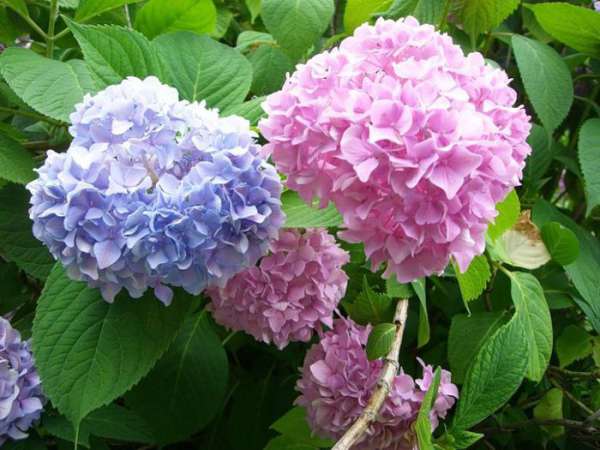

The hydrangea fruit looks like a box, in which there are from 2 to 5 separate chambers, each of which contains small seeds.
One of the most popular types of hydrangia is a large-leaved species, the inflorescences of which have sterile large flowers. About 600 varieties of this shrub have been bred.
Attention! Hydrangea is a poisonous plant, therefore it is forbidden to use it for food.
Can I change the color?
Changing the color of home hydrangea is a separate fascinating topic. In some cases, the color of the petals depends on the composition of the soil, so if you want to get blue flowers, the earth can be enriched with iron salts (simply by adding iron shavings or ordinary nails to the pot of earth).
Note! Another option is to spray the hydrangea with a solution of potassium alum: 7-8 g per 1 liter of water. This should be done twice a week. Then pink flowers will turn blue, dark pink - violet-blue, and red - pure purple.
Growing features
Hydrangea grows best in acidic soils. For better air penetration into the soil, the ground around the shrub must be periodically loosened.
Hydrangea does not grow well in sunny areas, so it is better to choose a planting site in the shade or partial shade. In a sunny area, the plant develops more slowly, and the flowers become smaller.
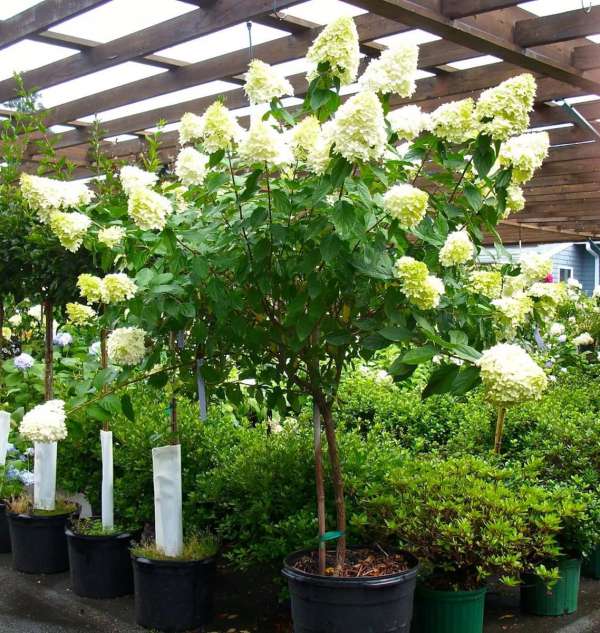

Hydrangea grows poorly in sunny areas
Watering hydrangia should be done with settled water or rainwater, since the shrub does not tolerate lime well. Watering time is morning or evening. This will help the plant avoid sunburn. Once a week, at least 2 buckets of water are poured under an adult bush.
Hydrangea propagates by green cuttings.
Planting is usually carried out in the spring when there is no night frost.
2-3 weeks before planting, they dig a hole, up to 0.5 m deep, and with sides up to 0.7 m. Turf, leafy soil, sand and peat are poured into it in equal proportions. It is not recommended to prepare alkaline soil, since its alkalinity is a possible cause of hydrangea chlorosis. Further, mineral fertilizers and organic matter are introduced into the planting hole. The root collar of the seedling should be at ground level.
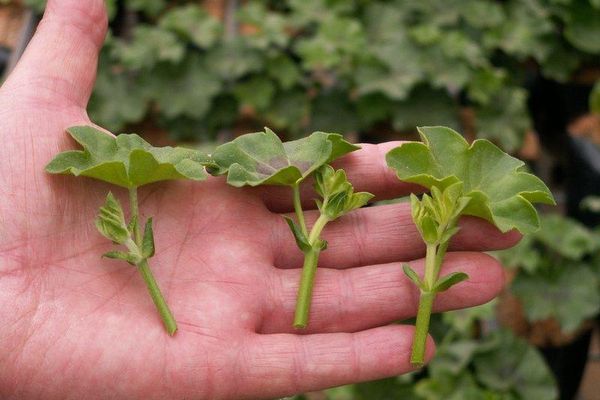

Hydrangea propagates by green cuttings.
Starting from 3-4 years old, they perform an annual molding of the bush.
Chlorosis
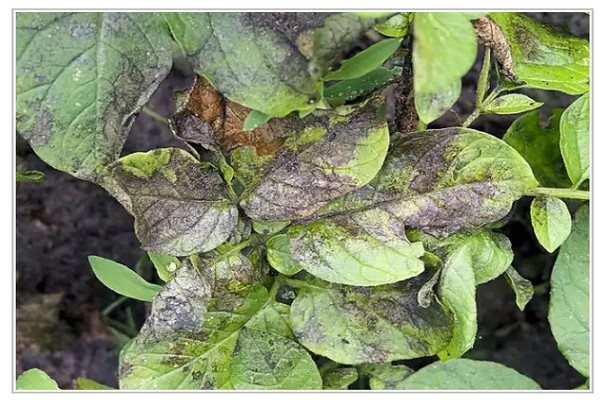

Chlorosis is one of the diseases that can develop as a result of a lack of iron in the soil and, accordingly, in the plant's body. The leafy part begins to gradually turn yellow, and the veins can retain their green tint, but, one way or another, the bush is already losing its decorative properties and looks very painful. In general, chlorosis can manifest itself in very different ways. The leaves may stop growing, they decrease in size, their color ceases to be bright and juicy, the plate itself begins to curl and deform, and the buds become less decorative, which also indicates that the plant was affected by a disease and needs help from the gardener. There are several measures to combat and additional prevention of chlorosis, which are worth paying attention to. So, you should carefully monitor the characteristics of the soil, since for planting a hydrangea, it must be prepared, it must be nutritious and loose, so that oxygen is regularly supplied to the root system. It is also worth adding regularly acidified moisture, because thanks to it, the necessary and, most importantly, the correct balance of the soil will be preserved. If suddenly the disease still began to manifest itself, then it is best to immediately carry out treatment with iron-containing preparations. Among them, the most effective are such as Ferovit or Antichlorosis.It is best to apply the preparations on the leaf, so that it is sooner absorbed into the plant and gives a faster effect, since due to the peculiarities of the root system, the necessary effect can be expected too long, and during this time the plant can become even more sore.
Leaves are also affected with a disease such as septoria. Dark brown spots appear on the leaves, which begin to noticeably increase in size, as a result expanding and affecting the entire leaf plate entirely. Then the leaves turn yellow, deform, curl and, as a result, die altogether. If the treatment of septoria is not started on time, then it can lead to the fact that the plant completely discards all the deciduous part. Also, with the spread of this disease, not only the leaves themselves, but also shoots, petioles, and inflorescences can be affected. Of course, it is not only necessary to fight septoria, but even necessary, otherwise there is a great risk that the plant will cease to exist altogether. Among the measures to combat septoria, we will single out such as:
- leaves that have already fallen off, it is recommended to regularly collect and immediately destroy so that the bacteria that are located on them do not spread to healthy plants
- if the shoots were affected by a disease, then they must be cut off, and the cut sites must be treated with garden varnish in order to protect them from bacteria or fungal spores
- in the spring, it is recommended to process the plant with Bordeaux liquid. Also, for an even greater effect, you can use some chemicals, including substances such as Ridomit Gold and Profit. But it is also worth remembering about safety precautions and that the gardener must use any chemical or biochemical preparations in accordance with the instructions for use. Otherwise, you can harm not only the plant, but also yourself. If the hydrangea is grown in greenhouse conditions, then it is worth constantly monitoring and regulating the humidity of the air, since for this reason, diseases that are dangerous to the life and health of hydrangeas can often form.
Why does hydrangea wither
If the care of the shrub is correct, then it has a luxurious look throughout the growing season. If the technology of growing a plant is not followed, hydrangia can get sick.
What to do if hydrangea dries
First you need to determine the cause of the disease. If the leaf dries, then the reasons for this may be:
- incorrect soil pH;
- direct sunlight;
- watering the plant with tap water;
- lack of moisture in the soil;
- insufficient or excessive amount of trace elements in the soil.
Incorrect soil composition
In order for the shrub to develop well, an important condition must be met - the soil can be acidic or moderately acidic. For hydrangea, the pH should be in the range of 4.0-6.0. In the case of alkaline soil, the leaf will begin to dry out over the entire area.
Attention! The color of the leaves of the plant depends on the acidity of the soil. The more acidic it is, the darker the leaves of the hydrangea.
If the soil is alkaline, then the acidity of the soil can be restored by irrigation with acidified water (for example, with the addition of lemon juice).
Insufficient plant nutrition
If the leaves turn black or yellow, then the soil may not have enough iron or nitrogen.
During the flowering period, it is necessary to feed the hydrangea with a complex fertilizer intended for flowering plants.


Fertilizing the shrub with iron chelate
Also, a lack of trace elements can occur in the spring, when the hydrangea begins to actively develop. How to reanimate hydrangea in this case? To do this, you need to carry out foliar feeding of the shrub with iron chelate.
However, hydrangia responds poorly not only to a lack, but also to an excess of fertilizers. Therefore, after the end of flowering, it is necessary to reduce the dose of applied mineral fertilizers.
Excessive sunlight
One of the reasons why hydrangea leaves dry out is because the plant is not in the shade, but in the sun.
Hydrangea grows poorly in direct sunlight. Therefore, resuscitation consists in transplanting a plant in partial shade or creating an artificial shade using a special shading mesh.
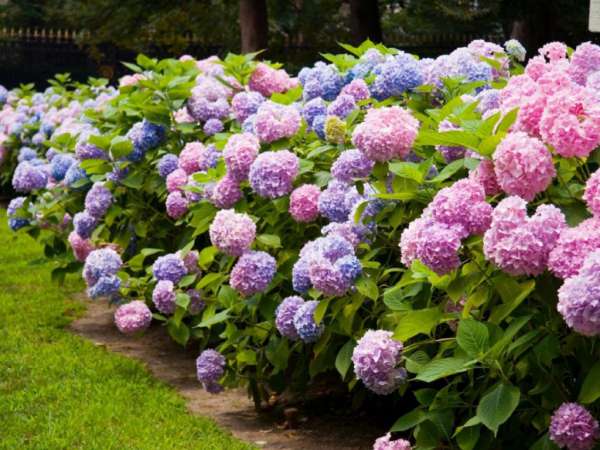

Excessive sunlight
If the shrub is home and grows indoors, then it is best to place the pot on the west or east window. You also need to make sure that the leaf does not touch the window glass. If the sheet touches the glass, the sun can burn it.
Insufficiently moist soil
Due to a lack of moisture, the leaves of the shrub will dry out over time.
Hydrangia is a moisture-loving plant, therefore, mandatory regular watering will allow you to get beautiful flowers.
To revive the street bush will allow an increase in watering, as well as mulching the soil. If the bush is indoor, then you can use a humidifier. Instead, you can install a container near the flower, into which water is periodically poured.
However, the plant also does not like an excess of moisture, since this contributes to the development of root rot.
Using hard water for irrigation
Tap water contains many impurities, including lime. And hydrangea is quite sensitive to them. Therefore, it is best to use settled water for irrigation. To do this, you can use special open containers, which are best placed in the sun. In this case, you can get warm and soft water for irrigation.
Why do hydrangea leaves dry
A common problem is the leaves dry. As a result, it does not develop, withers like a plant and does not produce large luxurious flowers. There are several reasons why this process can occur.
Dry ground
The first reason why hydrangea leaves dry out is overdried roots. The flower is very fond of wet soil and requires adherence to the watering regime. It is also worth considering watering time and plant illumination. In order to save the hydrangea, which has dry leaves and flowers - water it on time, enter the spraying into the care system and darken the flower a little for a while.
Sloppy transplant
Due to improper actions, the root system is disturbed. Hydrangea can dry out and wither after transplantation, during which small roots were disturbed. They are responsible for plant nutrition. To avoid problems with leaves and flowers, replant the flower in the spring. Do not crush the earthen ball, but transfer it into a new large pot. Choose a slightly acidic and loose soil. Deepen the neck of the plant a couple of centimeters, but not more. Observing such conditions, you will not need to save the hydrangea, whose leaves are drying.
Excessive soil moisture
Waterlogging of the soil is also one of the causes of foliage falling. At first glance, a flower that loves moisture cannot dry out due to constant watering. But this is not the case. Since the root system, especially the small one, is responsible for nourishing the flower, waterlogging can adversely affect the state of the foliage. Roots that get too much moisture simply start to rot and die off. As a result, the leaves do not receive nutrition and fall off.
In order to reanimate a hydrangea in a pot with diseased roots, carefully pull out the plant and cut off the rotten roots. They will be brown. Sprinkle the cut sites with activated carbon. Transplant the flower into a new pot that is smaller than the previous one. Also for a week or two, you can cover the flower with a portable compact greenhouse. Also consider ventilation in this design.
Low air humidity
It is very difficult for a plant that loves moisture to survive dry air. Therefore, the tips of the leaves begin to dry out, after which the entire leaf dries up and falls off. What to do if hydrangea dries up in dry climates or? Outdoors - Spray the plant as often as possible.At night, you can create a small stationary greenhouse for hydrangeas. Reanimating large-leaved hydrangea, which is grown in a greenhouse, is easier. It is recommended to humidify the air with a humidifier. It is also worth ventilating the greenhouse as often as possible.
It should be noted that hydrangea is a flower sensitive to soil pH. If the soil is within the normal range for the plant, the flowers change their color. For example, in neutral soil, hydrangea flowers become beige or white, in acidic soil - red, and in alkaline soil - blue or purple. If the soil goes beyond the comfortable pH for the flower, it begins to be capricious and sore.
Landing errors
One of the reasons why hydrangea leaves dry at the edges are the mistakes that were made when planting the plant.
Damage to the root system
Hydrangea has a very delicate root system, so the plant must be transplanted very carefully, without damaging the small roots. Damage to them can lead to the fact that the bush will be difficult to take root and hurt for a long time.
Attention! Buying a seedling is a very responsible business. It is important to check the health of the root system.
Also, you cannot prune the roots when planting. It is allowed to trim the roots only if they are rotten, diseased or damaged by insects. Rotten roots are dark brown, and healthy ones are white. The cut sites are processed with crushed activated carbon.
Watering with the addition of Zircon, which is performed once a week, can help the better survival of the plant.
Errors when choosing a landing site
If the soil is not acidic, but alkaline or neutral, then the plant will be difficult to take root. Therefore, in this case, it is necessary to acidify the soil, otherwise the bush may dry out.
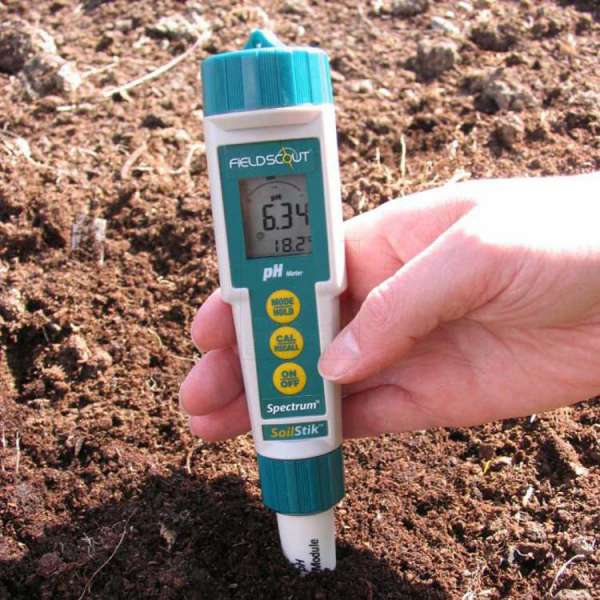

If the soil is not acidic then the plant will be difficult to take root.
If a garden is chosen for planting, then it is important not to place the seedling in a draft, it is also necessary to protect it from sudden temperature changes and hypothermia.
Why do hydrangea leaves turn yellow
Dry leaves of hydrangea are sometimes accompanied by yellow or black spots. In addition to improper care and the fact that yellow leaves spoil the appearance, they can be a sign of a disease in a plant:
First, to understand the reason why hydrangea leaves curl, inspect the plant and exclude the presence of pests. To do this, inspect the sheets from the inside. If you find unwanted guests, start destroying them with drugs.
If the flower turned out to be clean, it means that the cause of twisting lies in the viral infection of the plant. In this case, the fight for a healthy plant should be aimed at restoring its immunity.
Observing all the rules of caring for such a whimsical flower, he will very quickly delight you with luxurious flowers!
Let's help the plant - video
Room hydrangea leaves dry for several reasons.
Garden hydrangea (lat.Hydrangea opuloides), or hydrangea, is perhaps one of the most beloved indoor plants among domestic gardeners. He was loved for unpretentious care and beautiful flowering.
The homeland of hydrangea is Asia, America and Japan. This deciduous shrub blooms for almost six months from spring to autumn, dissolving up to 6 "caps" of inflorescences on each bush.
However, like every houseplant, even such an unpretentious variety as hydrangea, there are problems associated with caring for it.
Hydrangea diseases
What to do if hydrangea leaves wither? Perhaps the plant is sick. To choose the right treatment method, it is important to accurately identify the disease.
Dry blackening
If the edges of the leaf are covered with brown spots and become dry, then this indicates that:
- the plant is watered with hard water;
- the leaf was sunburned.
After the stains appear, the foliage will wither and wither.
Wet blackening
The leaves darken and lose their firmness. This may be due to:
- sudden changes in temperature;
- exposure to the draft of the place where the bush grows;
- excessive watering;
- heavy soil.
Why is the garden hydrangea still withering? A possible cause is a fungal infection of the plant.
White rot
Fungal root disease. With such a disease, the bush gradually dies, since the affected root system cannot provide the plant with the required amount of nutrients.
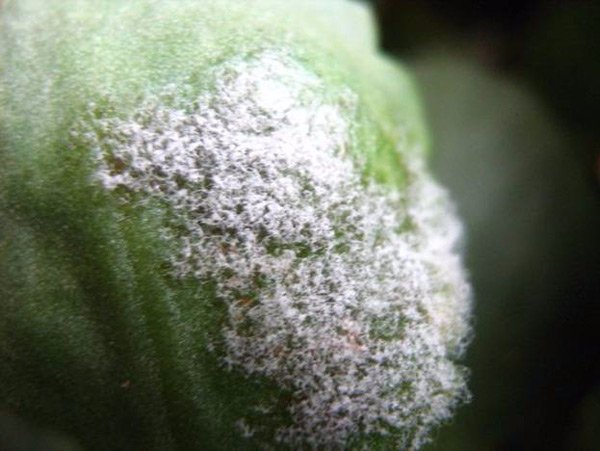

Symptoms:
- white, cotton-like plaque on the shoots;
- blackening of shoots.
To treat the affected plant, fungicides Fitosporin, copper oxychloride, etc. are used.
Gray rot
Symptoms:
- Flower tissues become soft and watery;
- The affected parts of the plant die off in a dry environment. After them, holes remain on the stems;
- In a humid environment, the affected areas become covered with a gray coating.
The diseased areas are removed mechanically. Then houseplants are treated with Chistotsvet, Fundazol or Skor. Garden species are treated with Rovral Flo 255 SC, every three weeks.
The appearance of dark brown spots, up to 6 mm in size, on the leaves. The affected leaves gradually begin to dry out and die off.
Treatment with copper-containing preparations, for example, copper sulfate.
Powdery mildew
The formation of yellow-green spots on the leaves. Gradually, the spots darken and acquire a brown color. The back of the leaf is covered with a purple or gray coating. Winter for a diseased plant usually brings death.
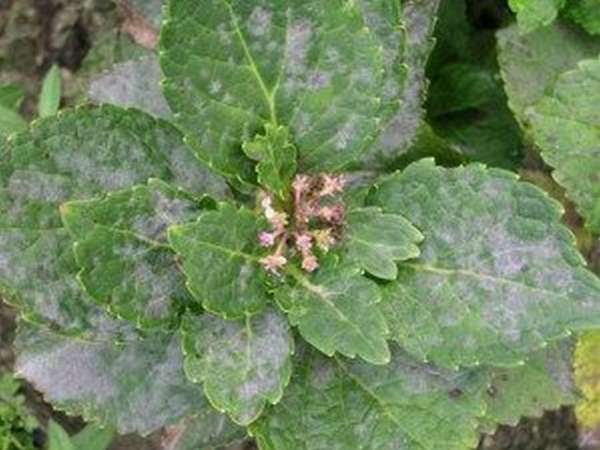

At the first symptoms of damage, the fungicide Fitosporin is used, and in an advanced form - Skor, Topaz or Chistotsvet.
Thus, when purchasing a seedling through a store or on the market, you need to make sure that the young plant is not susceptible to fungal disease.
Hydrangea leaves wither - reasons and solution
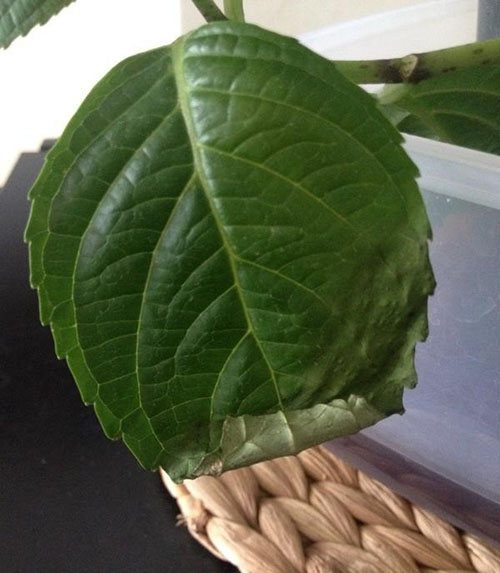

We carefully examine the plant and look for a reason to provide the right assistance to the plant.
Excessive hydration
Abundant and frequent watering of the flower, too high humidity of the air can also harm hydrangeas and cause a violation of the condition of the roots and leaves. Accordingly, if the deciduous-root system is disturbed, the plant will not be able to form normal peduncles and please with abundant color. If a hydrangea in a pot has begun to fade, the first step is to transplant it. Change the old earthen ball, but not completely. Remember that the root system, especially a young one, is very sensitive - it can be easily injured. Transfer the plant to new soil and a new pot. Reduce the humidity level in the air. Ventilate the room as often as possible, but at the same time protect the hydrangea from drafts.
Temperature drops, drafts
Frequent and sudden changes in temperature, the presence of drafts harm such a delicate plant as hydrangea. From changes in temperature (night and day shifts), the leaves of the hydrangea turn black and dry. For flower resuscitation - normalize the air temperature. Try to achieve + 20-23 degrees. This indicator is considered comfortable for hydrangea. With strong wilting of the leaves, some of them can be cut off.
If your beauty is not blooming, and you still do not deprive the hope of contemplating these lovely bouquets of flowers, arrange a period of rest for the hydrangea. This means that it is necessary to lower the temperature to + 10-13 degrees.
In this case, it is necessary to reduce it to a minimum - just watch that the flower does not dry out. Also, during the dormant period, the plant must be hidden in a dark and secluded place. In a couple of weeks, small flower stalks will appear on the hydrangea, which will delight you with beautiful and lush flowers.
Heavy and dense soil
Pay attention to the consistency of the soil in which you plant the flower. Hydrangea needs loose, light and at the same time nutritious soil. Heavy and dense soil will retain moisture and, as a result, the flower will not be able to eat and breathe normally.
Please note that garden hydrangea is especially whimsical to the composition of the soil.In addition to the wrong density of the earth, the level and balance of micro and macro elements is also important for it. Violating these wishes of the flower - the leaves of the garden hydrangea may begin to wither, and then fall off.
Disease prevention
Inspection of seedlings and proper care of the plant are the main prevention of diseases. It is imperative to loosen the soil around the plant during the entire growing season.
In the spring, you can treat the plant with copper-containing preparations, for example, copper sulfate (100 grams per 10 liters of water). You can also use drugs Topaz, Fitosporin, etc.


At the end of spring, it is necessary to make nitrogen-containing dressings, in the summer - phosphorus-potassium, and in the fall - phosphorus.
Disease prevention
Prevention is always safer and more effective than cure. Here are the main preventive measures:
- Correct acidity and mineral composition of the soil. You need to water it with soft water, when applying nitrogenous fertilizers, be careful not to overdo it, otherwise the hydrangea leaves turn black and dry.
- Sun and humidity. Hydrangea loves diffused light and grows normally in the shade. Direct sunlight in summer can cause burns, and dry ground increases the risk of powdery mildew and downy mildew.
- Planting material must be selected carefully so as not to introduce dangerous viral diseases.
- To protect plants from fungi and viruses, you need to disinfect the tool that you used to work with diseased plants, burn the affected parts of the plants. Good protection from infectious branches and drying out of the earth is given by soil mulching.
- Prevention of fungi. Before the start of active growth of shoots, in the spring, hydrangeas need to be treated with fungicides.
How to save a wilted hydrangea
If the bush is dead, then you can try to revive it. If the plant is garden, then in the spring all frozen parts are removed. If the plant is affected by rot, then the cut is performed 1 cm below the affected part. The cut points must be sprinkled with ash, activated carbon, etc. After trimming each affected area, the pruner is disinfected. The treatment of the bush is carried out with drugs, depending on the disease.
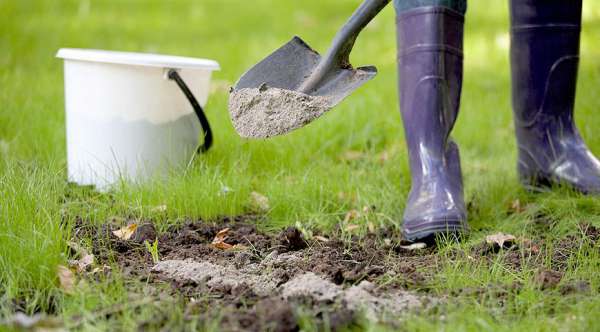

Wood ash for fertilization
How to revive a cut hydrangea? If a withered flower is in a vase, then you need to get it out of there, cut off the lower part obliquely and place the plant in boiling water for 3-5 minutes. After the air bubbles have finished coming out of the stem, you need to get the plant, cut off the part that was in the boiling water, and put the flower in cold water. After that, your vase will look festive again.
Hydrangea dries at home in a pot
If the beginning of a houseplant disappears, then it must be brought into the house (if the pot was on the street), cut off the entire affected part and treated with HOM for fungal infections.
In the case when even the entire green part has died, there is still no need to throw out the hydrangea. Continue to water the potted soil in moderation. Perhaps after this dormant buds will wake up, and the plant will grow again.
Pests and parasites
Leaf aphid
Small parasitic insect. Finds the soft parts of the plant and sucks the sap. In small quantities, it does not pose a threat. Usually, the number of aphids is regulated by natural enemies - ladybirds, lacewings, and some beetles. However, in large quantities, aphids can weaken or completely destroy the plant.
The aphid colony usually sits in clusters and is clearly visible on the plant. The first sign that aphids are on the hydrangea will be drying and yellowing of the leaves.
- When the colony is small, it is enough to wash the plant with a soap solution or douse it with water from a hose.
- If the colony is large, you need to use special insecticides - Iskra, Bison, Akarina. The products are toxic, you must strictly follow the description and instructions.
On a note! Marigolds growing nearby attract ladybirds - natural enemies of aphids.Thus, planting these flowers serves as a natural prevention of aphids.
A proven home remedy is tobacco dust decoction. The advantage of a home remedy will be its less toxicity compared to insecticides.
Spider mite
A tiny tick, almost invisible. It feeds on plant sap. It actively reproduces in the dry hot season.
You can recognize a tick by the appearance of a thin web on the leaves. When the plant is severely infested, the colonies are visible to the naked eye as a cluster of tiny reddish specks on the leaves and stems. The leaflet affected by this parasite can curl and curl up.
- As long as the damage is small, you can get by by applying soap solution or any mineral oil to the leaves.
- In case of dangerous infection, special anti-tick agents are used - Akarin, Lightning.
The healing effect of tobacco dust is not as great as against aphids.
Gall nematode
Microscopic primitive worm. It affects the roots of plants, makes its way into the trunks. Having multiplied, it can literally poison the plant with caustic secretions.
The nematode can be recognized by the red galls on the roots and at the base of the stems. These blister-like bumps begin to rot and die off. The affected plant slows down growth and may die if the parasites are allowed to multiply.
Important! If the plant is infected with a nematode, there is no reliable treatment. So all hope is for prevention.
- The natural enemies of the worm are other predatory nematodes and special fungi that parasitize the worms. To increase their amount, sugar is laid in the ground (in small quantities).
- The chemicals Aktofit and Fitoverm do not kill the natural microflora of the soil, but they fight the rootworm nematode. They are introduced into the ground a couple of days before planting.
Garden slug
Slug eats plant leaves, prefers young leaves and shoot tips. Feels especially well in dense thickets, loves shade and high humidity. Slugs are easy to spot by characteristic damage to the leaves; they usually hide in the axils of the leaves or under stones in shaded places.
Slugs are a serious danger for very young plants, in spring in greenhouses.
Slugs are usually collected by hand, the clutches of their eggs in the axils of plants are destroyed. Specialty chemicals such as Shellfish are toxic.
Preventive treatment with preparations containing copper and fungicides will help resist fungal infections. Seedlings of hydrangeas should be healthy and not arousing suspicion, this will avoid viral diseases, for which there is simply no cure.
The most dangerous pest of hydrangea is the rootworm nematode, against which only prevention helps. Suitable soil, proper care and attention will protect hydrangeas and keep them healthy.
Help save the hydrangea!
This year, in July, circumstances again brought me to the Aivazovskoye health-improving complex, when the laying of the Hydrangea Garden was almost completed. And I was again shocked by what I saw! The fact is that the first hydrangeas appeared in.
Please, help. Long dreamed of hydrangea! I bought it, while waiting for the landing time, I filled it with water. She pulled out an earthen lump from the pot. I could not separate the earth from the roots, everything is intertwined. It seems that the roots have not rotted, but all the shoots are with leaves.
In mid-July, forcibly, she transplanted a panicle hydrangea from partial shade into the open sun. The hydrangea tolerated the transplant perfectly, despite the fact that it happened during flowering. In a new place, the hydrangea began to grow and grow.
I have a big panicle hydrangea, she is 6 years old, I cut it short in the spring, coniferous litter is poured around the bush, I seem to do everything as it should. But she cannot have time to form buds, not to mention flowering, although they write that they are blooming with.
A question from our subscriber Olga: I'm in trouble. Since February, I have been growing the bushes of Hortensia and Jasmins (Chubushnikov) on the windowsill.They grew up big, beautiful. Recently I landed on a site in open ground. We have a very sunny and windy area and….
This hydrangea is very dear to me, it was presented to me and planted by my beloved friend, who has already died of a terrible disease 3 years ago. Hydrangea bloomed with blue inflorescences - caps, but unfortunately, only the first year. I tried to cut it.
See all materials about hydrangeas: See all
How to fix the problem
If the leaves of the hydrangea turn black, the gardener should determine the factors of negative influence. With improper care, you should also study the rules of agricultural technology of the bush and establish the maintenance of the beauty.
If the reason for the decrease in decorativeness is a disease, fungicidal preparations and copper solutions are used. In case of an invasion of pests, the bushes are sprayed with insecticides.
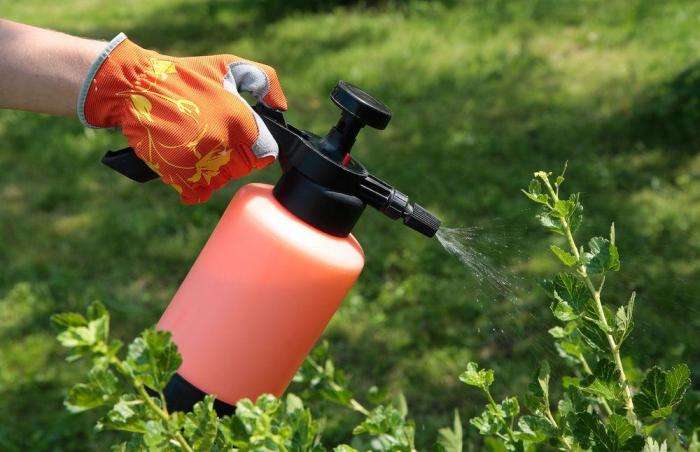

Hydrangea is a wonderful crop and is considered very easy to care for. It easily tolerates the vagaries of the weather, but for its successful cultivation, it is necessary to create optimal conditions. In this case, the gardener has the opportunity to admire the high decorative effect of the bush throughout the growing season.
These flowers do not get sick too often, hydrangea diseases are usually caused by several reasons - poor-quality seedlings, an unsuitable place for planting and mistakes in care. All diseases can be divided into fungal, viral and parasitic infections.
Can a hydrangea be saved?
There are not so many perennial ornamental plants in our gardens that can compare in attractiveness with hydrangeas. They can sing odes long and beautifully, praising the power, variety of species, delicate delicacy and ceremonial splendor. But nothing.
Good day! Tell me how to save a hydrangea? From a bouquet she rooted cuttings in the shade under a film in the summer, transplanted them into pots (into the ground from the garden) in the fall and brought them home. 4 leaves have grown. Now in February I noticed that the leaves are brightening, and the veins.
I bought a pink hydrangea in the fathoms market. I was told that she needed to be covered for the winter. But the trouble is that we are leaving the dacha early, somewhere in early October, because there is no good road. I am afraid that the bush will crush. I was advised to plant this bush.
I read a lot about the fact that broadleaf hydrangeas usually bloom on the shoots of the last year, and this is associated with all the difficulties with their re-flowering in subsequent years. At the same time I read that many modern varieties winter well and can already.
A question from our subscriber: Dark spots appeared on the sheets of paniculate hydrangea. What could be the reason?
I received hydrangea seedlings in the mail. "Russian Garden" pleased with the packaging. Hydrangea roots in pots in a substrate with hydrogel, already oozing. The roots, by the way, I checked, are in place and are pretty. ) I think in this form and hold the paniculate up.
See all materials about hydrangeas: See all
Hydrangea viral diseases
Typical ways of introducing infections are with a garden tool, from a nursery, with new plants, or with dead parts of infected plants. Pest animals can also carry viruses.
Ring spot
It spreads regardless of external conditions, it is dangerous for panicle hydrangeas.
Symptoms: Ring-shaped spots are formed on the leaves. At the next stage, the leaves lose their shape, shrink, fall off.
Important! The disease is contagious for the nightshade family, strawberries, grapes, currants. Also dangerous for onions, cucumbers, cabbage and celery.
A flower affected by ringed spotting is likely to stop blooming or produce weakened buds. Very often the plant dies. If the hydrangea is sick with this virus - what to do, there is no medicine, you will have to destroy the bush. All efforts should be directed towards prevention. Take planting material only checked, from healthy plants.
Hydrangea cancer
The disease appeared relatively recently, with varietal material from Western Europe.It is believed that weakened plants are susceptible to disease, especially those with mechanical damage, for example from hail.
Symptoms: brown spots on stems, leaves. On the reverse side, sores appear under the spots.
There is no cure for the disease. The best method of dealing with this is to remove and burn the affected areas. If the plant is deeply damaged, it is better to destroy it in order to avoid an epidemic. If the disease is not treated, the ulcers increase in size, the shoots die off and the plant dries up. There is no exact data on the infectivity of hydrangea cancer for other crops.
The hydrangea began to dry. What happened and how to save? - expert answers
Friends, your help is urgently needed again! My hydrangea is sick! I don’t know what happened to her. Grew and bloomed beautifully in this place for 3 years. And this spring, the leaves turned pale, almost yellow. I examined it for the presence of pests and.
Good day! This spring, I ordered a bunch of seeds of outlandish plants in the Samara online store. In gardening, to put it mildly, I'm a beginner, but since my own dacha appeared, I want everything at once. So by trial and error I am very slow.
Why do the petals "rust" on the flowers of a freshly blossomed white hydrangea?
Hello! At first, the leaves of the recently purchased hydrangea began to turn yellow. After reading the tips on the Internet, I poured warm, settled water with lemon juice. For a short time everything was normal. And now the leaves are dark.
Why isn't the curly white hydrangea blooming?
Good day! Treelike hydrangea is 3 years old. This year it blooms for the first time with the whole bush. But it worries that the leaves are small and very pale, and the inflorescences are some kind of skinny, not strong. Care - loosening, watering in the heat, mulch in the trunk circle -.
See all materials about hydrangeas: See all
Useful video
Learn about one of the diseases of hydrangea - chlorosis:
If you find an error, please select a piece of text and press Ctrl + Enter.
Hydrangea is a common plant in gardens and summer cottages. Many varieties allow you to choose the most appropriate option in accordance not only with climatic characteristics, but also with individual preferences. Due to its exquisite bloom and rich greenery, hydrangea is often used in the creation of exclusive landscape designs. The plant practically does not cause trouble, but it happens that the leaves of the hydrangea turn black, what to do, the florist must know without fail.
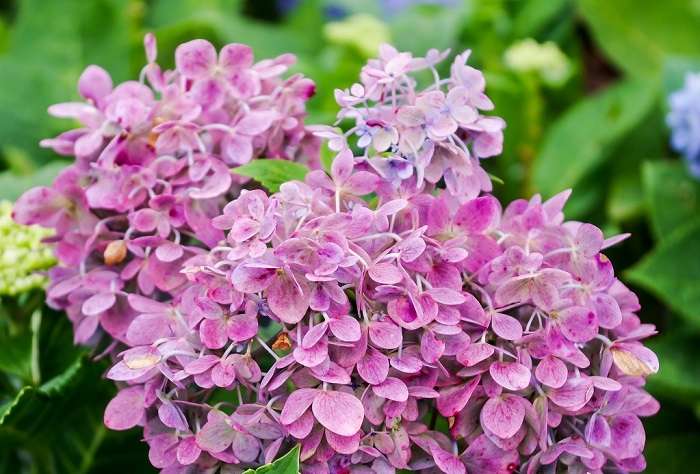

Plant viral diseases
Brown spots with a tinge of redness can be caused by viruses. One of the most common diseases is calcium spot. The consequences of this viral disease are visible on rolled leaves. First spots appear, which then change the shape of the leaves. The latter are being rolled up. Even inflorescences are occasionally affected.
This means that the defeat has taken on a large scale. The inflorescences weaken, become small, or there may be no ovary of new buds at all. Seeing the beginning of this process on the leaves, do not expect this flower to wither, infecting the rest of the plants. Calcium spot is incurable. It is not the sick hydrangea that should be pitied, but all the flowers in the garden around, otherwise the losses will be irreparable.
Treating diseased leaves
When the edges of the leaves dry, you need to react urgently, otherwise the plant may die. First, you should determine the cause, and only then choose a method of treatment.
The main methods of treatment:
- with an excess of moisture - it is necessary to suspend watering for a while or water it, but not so often;
- if there is a lack of heat, the hydrangea should be removed from drafts and placed in a warmer room;
- if there are not enough nutrients, you need to start feeding the flower. Experienced flower growers recommend applying fertilizer to the pot when watering with water, you also need to use soft and settled water for watering.
With an insufficient amount of iron in the earth, the acidity of the earth should be restored. In this case, vinegar essence must be added to the soil. Prepare the solution as follows: take 1 teaspoon of the essence and pour it into 10 liters of water. By the way, vinegar can be replaced with oxalic acid. In addition, to restore the acidity of the earth, a ferovit solution should be used.
In case of viral diseases, diseased leaves must be removed, and the flower must be treated with fungicides. Quite often, professionals use Bordeaux liquid against diseases (1%). If you properly care for the hydrangea, the edges of the leaves will not turn yellow and dry.
Some fungal diseases and leaf redness
Spots and the appearance of a whitish coating over time are a frequent manifestation of a fungal disease. Hydrangea is not very susceptible to this type of disease, but, nevertheless, one should be prepared for such an outcome of events. The leaf cover, like the shoots, can significantly change color, the darkening acquires brown-red and dark shades. If the leaves turn black and then become covered with a whitish bloom, then white rot has begun. This disease appears on the root system, the decay of which is reflected in the appearance of the plant. Any fungicide, especially Fitosporin, can save the day.
Spotting with the subsequent formation of holes due to the withering away and drying out of the watery tissues of the flower is a bright manifestation of the next fungal disease. It is called gray rot. Over time, not only the leaves, but also the entire plant will be covered with a gray bloom. Fungal spores multiply quite rapidly in conditions of sufficient moisture, therefore, not only hydrangea, but also all nearby flowers are "under attack". All that can be done is to track any deviations in the development of the plant. As soon as the leaves begin to curl, the edge dries, you should react immediately, because each problem negatively affects the inflorescence.
The reasons why the leaves of room hydrangea dry include the following fungal diseases: tracheomycotic wilting, phyllosticous and ascochitous spots. In this case, fungicides come to the rescue.
Drying can occur in other cases as well. Reddish and brown spots on the leaves can be a clear manifestation of septoria. Its peculiarity is that the roundish spots at the edges are darker than in the center. They grow not only on foliage, but also on stems and cuttings. If you do not cope with the disease, the defeat occurs everywhere: the foliage dries and dies, the plant is not able to survive. Often occurs in the fall. They are treated with medicinal preparations.
The leaves curl and wither if the plant is harmed by the goose, leaf beetles, bronze, earwigs. Among pests, gall nematode requires special attention.
Most often, young flowers or those who have not been given the necessary care are affected. Hydrangea does not receive the necessary minerals and useful components, not only does the tips of the leaves dry out, but also a putrefactive process is observed on the roots due to the formation of swelling (or gall). One process stems from the other. Over time, if the microscopic worm is not neutralized, the leaves will not just fall off, but the entire plant may die.
Taking action
The choice of a plant when purchasing should depend on the condition of the root system. What you should watch out for:
- the roots correspond to the size of the plant itself;
- this eliminates the presence of putrefaction;
- lack of parasites.
Cutting should be done in the fall when there is no frost. Cut back a little to keep the 2 young buds on the run. When the frost is over and you start preparing the plant for flowering, you will need to make the branches a little shorter to make the buds appear larger.
Interesting facts: The largest flowers are in the large green hydrangea. It should be planted in partial shade as it is exposed to sunburn.
When selling seedlings, the seller is likely to focus on his own profit, providing incomplete information about the plant. Hydrangeas are a heat-loving shrub, some species simply cannot exist in the northern regions, so the lack of flowers can lead to the death of the plant.
Solving problematic situations with hydrangea
How to deal with the problem and prevent each of them is indicated in the article below. After all, this long-flowering shrub with pink, blue and even whitish flowers can lose its external beauty if some factors go against the rules of care and cultivation.
Light and moisture
The leaves of the hydrangea wilt and even fall if the place for planting is not chosen correctly. This shrub should not grow in the shade or in an overly open space with full access to sunlight. The appearance of yellowness, brown shades on foliage and even its death is a natural result. The scorching sun can burn the leaves.
The lack of light will certainly be visible not only by the changes in foliage, but also by the deteriorated or lack of color on the garden hydrangea.
Only diffused lighting can save the plant from death. If it is not possible to equip some shed or to pull the net from above, then the only way out is to transplant. Partial shade from trees and shrubs, higher than hydrangea, is fine.
This plant is quite hygrophilous, but the lack of watering norms will lead to the fact that it will weaken. What to do if the foliage begins to change color and even fall off - the answer is obvious. Reducing the regularity, as well as the displacement of watering, will be the best solution, until the root system begins to rot.
Nutrients
Some actions should be taken despite the fact that the soil is depleted, it no longer contains nutrients and substances and minerals necessary for the plant. Saves the regularity of dressings. Mineral fertilizers are applied at least 1 time in 15 days, and organic fertilizers - 1 time in 30 days. Hydrangea can be sluggish if there is a lack of micronutrients and macronutrients. In this case, the rules for caring for the plant will help. In the spring, the flower should be fed with nitrogen-containing fertilizers.
In the summer, those solutions are selected, the action of which is aimed at abundant flowering. One of the most favorite dressings among gardeners is "Kemira flower". Autumn is the time when young shoots and flower stalks are laid. In order for the plant to prepare well for the dormant period, potash-phosphorus fertilizers should be used. The color of each leaf on a shrub can indicate a problem.
If the gardener has a store far away, then you can prepare fertilizer yourself at home. One of the main ingredients will be ginger peat. The second is humus from leaves. It is thanks to him that the acidification and saturation of the earth with minerals will occur, where this fertilizer will be applied. Then pine needles and sulfur are mixed. This is not difficult to do. It is only necessary to lightly sprinkle the dug earth with gray. Make only 3 dressings. One spring when new foliage appears. The other two are in the summer, while the plant blooms and smells literally and figuratively.
To the question of why the leaves of the garden hydrangea turn yellow, there is another answer. This is a lack of iron. The wilting and yellowing associated with this problem is neutralized by acidification. Acid solutions, which are almost always on hand, are fine. Diluted vinegar and citric or oxalic acid are used. A teaspoon of any of the above substances in 10 liters of clean water will save the day. Burying nails and canning lids, tin cans and adding a ferovite solution to the soil will make up for the lack of iron.
The soil
Garden hydrangea needs acidified soil. As soon as alkalis prevail in the soil, this affects the color of the foliage. The fight against this problem is quite simple. Lemon juice should be added to the water for irrigation. For 1 liter of pure species, up to 3 drops are enough.You can take a solution of vinegar essence for the same purpose. But here is a different relationship. You will need one teaspoon of liquid for 10 liters of water.
Temperature violation
Yellowing on hydrangeas is possible in cases where the plant regime is violated, because it is quite thermophilic.
Drafts and sudden changes in temperature will definitely negatively affect the flower. This can affect not only the foliage, but also the wilting of the entire shrub.
If it is not possible to create protection for the plant in this place in the form of a decorative hedge, shields or wicker, then it must be transplanted. Protection, the necessary care and the absence of drafts will help the flower to regain its strength. The leaves of the shrub dry up if the air temperature is above 30 degrees Celsius.
After sunset, the hydrangea can regenerate again. But if excessive heat is observed for many days and weeks, the bush cannot be saved - it will begin to dry completely. This does not mean that the flower will die. However, it will definitely not be able to please with juicy foliage or flowering this year. Hydrangea should be protected from the scorching sun with excessive heat as well as from drafts. However, it is better to create humidity during hours when the sun is not so aggressive by spraying.
Rust
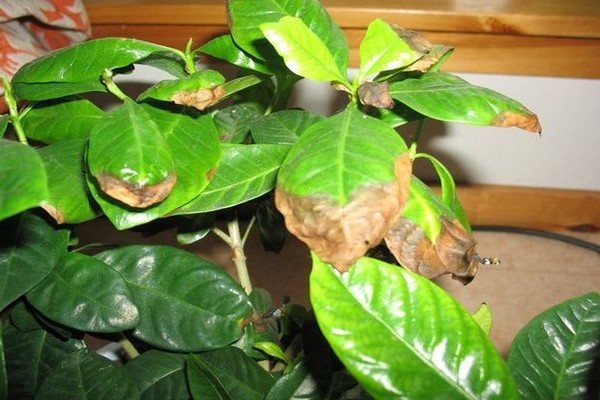

Rust is another fungal disease, due to which a rusty coating begins to form on both the leaf part and the flowers. Rust occurs most often due to the fact that the bushes are planted too close to each other, as well as due to the improper composition of the soil - an excess of nitrogen is noted in it, and this is what provokes the formation of some diseases, due to which the plant loses its attractive appearance and may even simply die in the future. In order to get rid of rust, it is recommended to treat the bush with copper oxychloride, and you can also use a solution of Bordeaux liquid, as it is considered no less effective in combating rust and any of its manifestations. You can also purchase some drugs in specialized stores - Ordan and Topaz, Falcon, which are used in accordance with the instructions for use in order to avoid mistakes in use and prevent the general health of the shrub from deteriorating.
Of course, hydrangea is often attacked by pests, which also cause the bush to become less attractive, its deciduous part becomes too vulnerable and not decorative. It is, of course, important to understand in time what kind of pest attacked the plant, and to take all the necessary measures in time to fight these pests and insects. Otherwise, the flower will begin to gradually wither, change its appearance for the worse, and in the future will completely die if you do not give it the necessary support.
How to cure chlorosis
Garden hydrangea can be affected by many diseases, and chlorosis is one of the most ferocious.
Due to this disease, the leaves of the plant become pale or turn yellow, while the veins on them darken very much. If you do not pay attention to these symptoms in time, over time the plant will lose its beauty, since all these signs are evidence of insufficient nutrition, in particular, a lack of iron.
Therefore, wherever you plant a hydrangea, regularly feed it with special fertilizers containing iron elements. The flower should be watered with soft water collected during the rain.
Also, do not plant a garden hydrangea in lime-rich soil, and try to use as little humus as possible to feed it.
But if the disease has already manifested itself, it is recommended to spray hydrangea bushes with one of the following drugs:
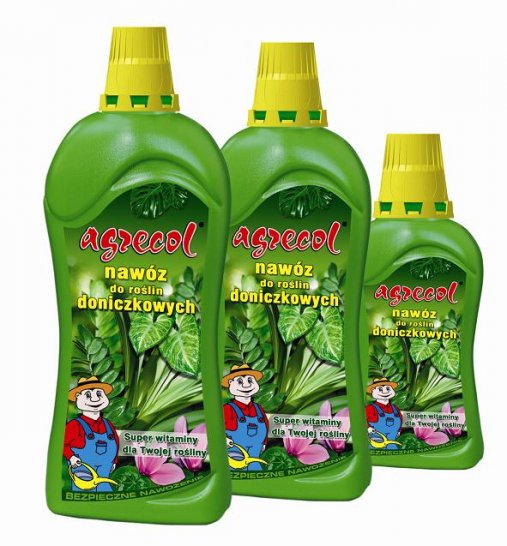

- Iron Chelate;
- Antichlorosis;
- Ferovit;
- Ferrilene;
- Micro Fe;
- Brexil.
In addition to spraying, these preparations can also be applied under the root of the plant, but only in very small doses.Also, against chlorosis of hydrangea, a solution is used made of 40 g of potassium nitrate and the same amount of ferrous sulfate, diluted in 10-15 liters of water. With this solution, you can water flowers in flowerpots and on a flower bed: we feed 2-3 times with saltpeter, then with iron sulfate, until traces of the disease disappear.
Causes of yellowing
Why did hydrangea leaves start turning yellow, what should I do? There can be several reasons for yellowing, but this usually happens due to inadequate flower care. In this case, it is necessary to reconsider the correctness of flower care.
Hydrangea leaves can also turn yellow due to errors such as:
- Excessive humidity. Home hydrangea loves moisture very much, but if you water it heavily, then the flower can only be poured, and this is quite detrimental to the leaves, which will turn yellow and fall off as a result.
- Lack of warmth. Hydrangea very poorly tolerates drafts and low temperatures. In such conditions, the leaves of the plant turn yellow and dry.
- Lack of nutrients. Home hydrangea for good flowering should receive the necessary micro and macro elements.
- Lack of lighting. In order for a flower to grow and develop normally, it needs good lighting. Hydrangea prefers bright and diffused light. But only direct sunlight should not fall on the plant, otherwise the leaves may get sunburn.
- Lack of fertilization during the period of active growth of the flower. If you do not apply top dressing, the leaves turn yellow and dry.
Why do the leaves of home hydrangea dry and what to do? A home flower needs nutritional components, and in particular during the flowering period. With a shortage of useful elements, the formation of inflorescences will be defective, and the tips of the leaves will turn yellow. This happens very often when the earth is deficient in nitrogen and iron.
What problems can arise?
Leaves dry - what to do?
Why do leaves dry? Most often, the cause of this trouble is an ordinary drought, in other words, insufficient watering. The solution to the problem is simple: change the irrigation scheme: the soil should be moistened a little more often or a little more abundantly. Dryness of the tips can also be caused by dry air in the room.
But the yellowing leaves indicate a possible decrease in the acidity of the soil. If the check confirms this, lemon water can correct the situation: a few drops of lemon juice should be diluted in 1 liter of water.
Treatment of diseases
Powdery mildew may appear on the leaves and stem of the hydrangea: it looks like oily spots that turn yellow over time. Heat combined with high humidity can be the cause.
Affected hydrangeas are treated with a composition that includes 150 g of green soap and about 15 g of copper sulfate, diluted in 10 liters of water.
Gray rot can be recognized by wet gray spots and bloom of the same color, they can appear on any part of the flower. Bordeaux liquid will help to cure this ailment, but all damaged leaves will have to be removed.
Reference!
But the fall of the leaves should not frighten the owners of the hydrangea. This flower belongs to deciduous, therefore, like many representatives of the flora, in this way it prepares for wintering. By the spring, foliage will again decorate the houseplant.
Pests and the fight against them
One of the most ubiquitous flower pests is the spider mite.
But if you take care of the flower correctly, you can not be afraid of its attack on the plant. Also, indoor hydrangea can be overcome by mealybugs, aphids and thrips, traditional for domestic plants. You can get rid of them with the help of special insecticides.
Vanille Fraise Blossom Description
Vanilla Fraser flower blooms for a long time, almost from the beginning of summer (mid-June) and does not bloom until the end of September.
It is no exaggeration to say that this is one of the most beautiful sandstone plants. Its inflorescences resemble an ice cone filled with strawberries and ice cream.During the flowering season, they become creamy, then pale pink, and in the fall they get a raspberry hue.
Hydrangeas of this variety are used for their modesty and long flowering period:
- for private and urban landscaping;
- in the composition of various landscape compositions;
- in some rows, like a hedge;
- for landscaping parks, gardens, farms;
- looks very impressive under lawns.
Good to know: When breeding hydrangeas of this type, their size should be taken into account - the shrub can grow up to 2 meters in height and up to 2 meters in crown diameter in a relatively short time.
Temperature, lighting, watering and fertilization
Optimal for hydrangea temperature
is a room in the range from 18 to 22 degrees Celsius. To ensure rest, the temperature must be lowered to 8 degrees Celsius.
Since indoor hydrangea is a light-loving plant, in winter window sills facing south or east are chosen for it. In other places it will be too dark.
Hydrangeas love well hydrated soil
... But since indoor options are grown in a pot where water can stagnate, the earthen lump should not be waterlogged. However, strong drying should also not be allowed.
For glaze
it is preferable to use soft water. The plant has a negative attitude towards tough. In winter, melt water is a good option. The flower requires regular spraying if the indoor humidity is low.
Feed
it is a houseplant with organic and mineral substances. During active development and flowering, fertilizers are applied every two weeks. Superphosphate and ammonium nitrate help hydrangeas bloom.
Leaf deformation: how to cure ring spot
Ring spot, which leads to deformation of the leaves of the plant, is the most common viral disease of this flower. The disease develops gradually:
at first, small lesions in the form of spots with fuzzy ring contours appear on the leaves of the hydrangea, then they dry them and force them to deform, making them asymmetrical.
When the ring spot is severely affecting the flower, it may not even bloom, or the bloom may be very weak. Unfortunately, it is impossible to get rid of this disease. The only measure to help you prevent it is to carefully select the seedlings for your flower bed.
Factors contributing to yellowing
Experienced gardeners know why the leaves dry and turn yellow in a garden beauty capable of standing in pyramidal inflorescences and green foliage until the very cold. But additional information will not hurt either them or people who are fond of flower cultivation.
The main reasons are hidden in the following factors:
- moisture (more precisely, excess moisture that poured under the plant);
- lighting (its large amount or lack is reflected in the change in the color of the foliage to yellow);
- lack of nutrients (the size of the bush and the long growing season require a sufficient amount of substances and trace elements, due to which the health of the plant will be preserved);
- improper soil pH (too low acidity can significantly worsen the appearance of the hydrangea and yellowing of the foliage - just the beginning of these changes);
- a temperature regime that does not correspond to the norms for a plant (if there are drafts that a shrub cannot tolerate or sudden changes in temperature, it is then that the leaves of the hydrangea dry out);
- diseases (powdery mildew and ring spot are the most common types that can lead to yellowing and subsequent drying of the leaves).
Reproduction
Seeds
Hydrangeas have very small seeds. They belong to the category of seeds with forced inactivity. Under favorable conditions, they can germinate without prior preparation.
Hydrangeas can be sown immediately after seed production.
Sowing on a compacted ground surface.
Sprinkle with a loose mixture (peat with sand, peat soil, clean peat). The thickness of the surface layer of mulch should not exceed 0.5 cm.
Sowing will take place in February. Substrate composition:
- deciduous land - 4 parts;
The containers are covered with a glass or transparent plastic bag. Spray water from a syringe. The bottom (for more information on how hydrangeas such as the bottom, see here) should always be moist.
Harvesting takes place after the appearance of the second true leaf. As the seedlings grow, they sit in cups or pots.
Layers
Hydrangeas can also be multiplied by retraction.
Young, half-ripe shoots have better roots.
Perennial branches practically do not give roots.
By dividing
During transplantation, the shrub is cut into several pieces.
Each of them must have roots and points of growth.
These dividers are planted in separate pots, watered and mulched.
Plants propagated in this way in spring will prevail until fall.
Lignified cuttings
One of the breeding possibilities is the maturation of woodcuts.
The bottom of the glass is filled with well-baked sand or pebbles. Fill with water.
The thickness of the water above the sand should be about two centimeters.
The cuttings are laid out on the sand. The water is changed every two to three days.
Interestingly, old hydrangea wood shavings are also rooted in the water!
Green cuttings
The most important type of breeding. Cut the hydrangeas in the room in the spring. To do this, choose strong roots with healthy leaves. The cuttings are rooted in a flower pot or on a level filled with soil. Planting depth 1-2 cm.
- The cuts are cut with a sharp knife just under the eye. The cut should be 5-6 cm long and have two to three pairs of leaves.
- The cut is dusted with wood powder to prevent the cut from rotting.
- The two bottom sheets are cut off.
- The soil is covered with well-washed sand, which is leveled and compacted to a certain extent.
- They make a pencil in the sand where they put the cuttings.
- They water the sand regularly to keep it moist.
Spray one to two shavings per day. Hold them by a bright window and protect them until they take root in direct sunlight. Usually the cuttings are well rooted. Adult, rooted cuttings are planted in pots with a diameter of 7-9 cm. They need grass, leaves and sand (4: 2: 1). Leafy soil can be replaced with plain peat.
Plants are kept by a bright, sunny window and plenty of water.
After passing the freezer pan, the plants can be taken out and dug into the ground.
If the roots are well braided in a pot of earthy clump, they make up an envelope of 11-13 cm pots. The composition of the potting mix is the same as when replanting mature plants. Further care is similar to caring for flowers and already cut hydrangeas.
What prevents hydrangeas from blooming in the garden
If you know the reasons that prevent flowering, you will quickly get closer to the desired result and will enjoy hydrangeas for a long time.
This prevents the formation of inflorescences:
- underdeveloped root system;
- Improper bleeding;
- unsuitable region for a certain type of hydrangea;
- improper care.
It is important to know that hydrangeas do not bloom in the yard or in the country until the root system has been established and strengthened. Nobody knows how long it will take.
The flowering time depends on several factors:
1.watering after planting (make sure the water does not stagnate) and sufficient to prevent the soil from drying out after 7 days of tillage.
2. Suitable soil and mineral fertilizers for all types of outdoor hydrangeas.
3. The place that you have prepared for the station must be accessible to sunlight.
Wood hydrangeas should be chosen by experienced gardeners to provide professional care.
Downy mildew
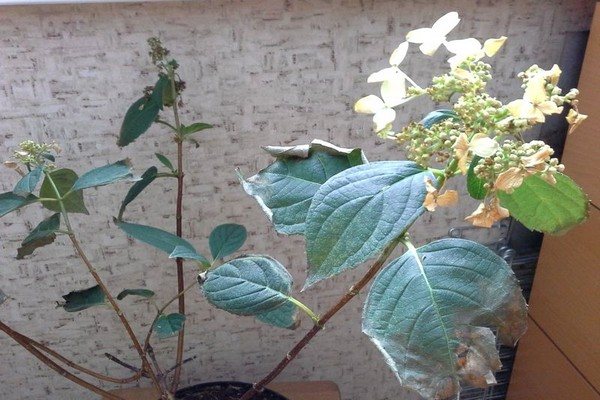

Downy mildew - it can be determined by the fact that large oily specks begin to appear on the leaves, which gradually spread to the shoots, which begin to turn yellow, and then darken. After that, a yellowish bloom forms on the leaves, and most often powdery mildew is found on plants that grow not in open ground, but in greenhouse conditions. In order to get rid of the pest that provokes downy mildew, it is necessary to carefully process the leaves and shoots with a mixture that includes soap and copper sulfate. The main thing is to carry out the processing on time and also to determine the disease in time, then the chances of saving the plant only increase, and this is very important, because not every gardener wants to lose the plant, and not everyone wants the hydrangea to lose its attractive decorative qualities. The amount and concentration of the solution should also be observed, otherwise you can cause even more harm to the plant, so you should not abuse the treatments, but too little of them will not bring absolutely any benefit.
Growing hydrangea Vanilla Fraze
She needs a 2/3 spring shoot of the shoot (for a lot of flowers).
For growing Vanilla Frays, it is better to choose a sunny spot or a bright semi-shaded area.
This plant prefers acidic soil or slightly acidic clay (read here for how to acidify soil). Landing takes place in the spring in the northern regions, and in the spring and autumn in the southern regions.
Hydrangeas of this species have a flat root system, but are very branched, so that the plant turns to moisture and soil fertility.
A third of the capacity of rotten soil or peat should be filled into each well at the time of planting. The borehole should be about 30 centimeters in diameter.
You do not need to cover the root soil too much with soil. The distance between the bushes should be about a meter.
It is good to know that it is good to mulch with dry sawdust or peat while waiting for freezing. This has a positive effect on the soil (acidification) and protects the roots from freezing.
Fertilizer
In order for the hydrangea to be strewn with flowers and you never have the question why the leaves of the room or garden hydrangea turn yellow, it needs to be fed periodically. It is best to do this once before flowering and once after flowering. For one adult plant, you will need three buckets of this solution: 20 grams of urea per bucket of water. And after flowering, mineral fertilizers are used for feeding. Fertilization is also allowed during summer flowering. During this period, slurry is used. But in this case, you need to know the limit so as not to overfeed.
Flower cancer: how to treat the disease
This disease began to occur in the flower beds of hydrangea fans not so long ago, since the European flower cancer arrived at our dachas along with imported varieties. Despite this, cancer is quite a danger to hydrangeas and is manifested by brown spots, under which ulcers form on the stems. The longer you ignore this disease, the more it will progress - the ulcers will deepen, the stems will begin to die, first in places, and then completely. The result is one - the hydrangea can dry out completely.
There can be many reasons for cancer damage to bushes: infected planting material, poor feeding, due to areas damaged by hail, with too dense planting of bushes. To cope with cancer, a whole range of measures must be taken:
- At the first sign of illness, try to remove all affected areas on the flower and burn them.
- If cancer appears on the roots, the bush must be completely removed and burned.
- Provide flowers with all the necessary mineral and organic elements, which will increase the hydrangea's resistance to various kinds of diseases.
When spots of yellow-green color appear on the leaves of hydrangea, which become darker and darker over time and acquire clear contours, you must prepare to fight a disease such as powdery mildew
because all these signs are her symptoms. It is clear that such leaves will not be able to survive on the stems for a long time and will soon begin to fall off.
If powdery mildew fungus will infect young shoots of hydrangea
, they will deform and will not be able to develop enough to survive the next winter. At the initial stages of the development of the disease, it is recommended to spray hydrangea bushes with fungicides, which are represented by the preparations "Alirin-B" and "Fitosporin-M".
In the event that powdery mildew has conquered most of the plant, spraying with such preparations will help save the flower:
- Pure color;
- Tiovit Jet;
- Speed;
- Topaz;
- Strobe;
- Cumulus.
Important!
Never touch the hydrangea inflorescences (for example, to remove flowers that have already wilted). Such an intervention can severely damage the plant, as a result of which unblown inflorescences may not open.
Seed planting
For a long time, the species hydrangea has been planted with seeds, but you will have to spend a lot of time and effort on this. In the fall, seeds are planted in prepared soil. It should include 4 parts of the leaf mixture, 2 parts of peat land and 1 part of river sand. After planting from above, the seeds are also lightly sprinkled with such a mixture and watered using a spray bottle. Then the container with seeds must be covered with foil or glass. Occasionally they will have to be ventilated, as well as watered with the same spray bottle. The optimum temperature for successful seed germination is + 14-20 degrees.
Within a month and a half, you will observe the first shoots. It is at this moment that the glass must be removed. The pick is usually carried out two times. The first falls at the moment when the cotyledons begin to develop, and the second - for the month of May. In May, seedlings are planted in separate pots 7 cm in diameter. During this period, they should be hardened, so in the afternoon the seedlings are exposed to the street. But you should choose a place where direct sunlight and rain will not fall. It will take you about two years to grow healthy and strong seedlings at home.
Planting seedlings
Healthy two-year-old seedlings are planted in open ground. For this, it is most suitable. Select a place for the hydrangea in advance. This should be a well-lit area without direct sunlight. Any soil will do. Take special care to ensure that there are no plants near the hydrangea with the same root system (superficial). This threatens that between them there will be a struggle for water and nutrients, as a result of which the question may arise: why the leaves of hydrangea turn yellow and what to do about it. Before planting, estimate the size of the plant's rhizome and make the hole twice as large. Peat, mineral and organic fertilizers are placed on the bottom. It is necessary to plant a flower together with the ground in which it germinated. Before filling the roots, they need to be leveled. After planting, the seedling should be well watered and mulched with needles or bark.
Gray rot: methods of struggle
Gray rot is no less dangerous for hydrangea, since its affected stems and flowers become very soft, watery, which eventually leads to their death. In this case, lesions can appear on the leaves and stems as dots, which dry out and fall asleep in hot weather, leaving unsightly holes behind. If the weather is damp, the disease will spread rapidly, and gray wool will also form over the affected areas.
It is very difficult to get rid of gray rot on garden hydrangea, since this disease is inherent in almost all garden plants, and hydrangea can become infected again.Nevertheless, if you regularly remove and burn all areas affected by the disease and spray the flower with the preparations "Skor", "Pure color" or "Fundazol", then soon all the symptoms will surely disappear.
Did you know?
Another name for hydrangea is hydrangia. It arose due to the fact that this flower is very fond of abundant watering.
Description
In its natural environment, a hydrangea bush can reach 3 meters in height. These are usually small trees and vines. Interestingly, some species of this plant can be evergreen, but in our regions, gardeners prefer deciduous species. Hydrangea has large, round leaves, pointed at the top and with small teeth on the sides. You can admire the flowering of hydrangea from spring until the first frost. Most species of this plant have white or cream flowers. But there is one species, large-leaved hydrangea, which can bloom with purple, pink and even red flowers. Interestingly, the shade of the inflorescence depends on the soil on which the plant is planted. Many gardeners have a question: why do hydrangea leaves turn yellow? You can find the answer to this and many other questions in the article.
Diseases
Why do hydrangea leaves turn black? Sometimes it happens that the care of the plant is carried out correctly, but the leaves still turn yellow, which means that the reason lies in something else. In some cases, hydrangea leaves turn yellow and dry due to disease. Although the plant is quite resistant to various infections, in certain cases it can be affected by diseases.
If hydrangea is exposed to diseases, then the reason is very simple - illiterate care of the plant.
The most common hydrangea disease is ring spot. When a disease affects a flower, its leaves not only turn yellow, but also become deformed.
In addition to ring spot, other diseases can attack the indoor flower:
- powdery mildew;
- chlorosis;
- white rot.
Powdery mildew
The disease manifests itself in the form of oily spots, which after a while turn black. The disease occurs due to high humidity. To get rid of powdery mildew, you need to treat the flower with soapy water, to which copper sulfate is added. Such treatment must be performed in the early stages of the disease.
Chlorosis
Why does chlorosis affect hydrangeas? The disease most often occurs due to improper watering. Chlorosis occurs when a plant is watered with cold tap water, where a large proportion of lime is present. With this disease, the leaf turns yellow and dries. In some cases, chlorosis leads to the death of the plant. Treatment of a flower from chlorosis includes spraying the plant with special preparations: Ferovit, Agricol, Ferrilene.
White rot
This disease is manifested by decay of the roots. With such a disease, the flower does not receive useful substances, then it begins to darken and dies. To eliminate the disease, the plant must be treated with a chemical such as Fitosporin or other fungicides. If you do not want your hydrangea to be affected by various diseases, then the care of the plant must be correct.

